“A Coffee House for the Sponge People” The Rise and Fall of The Crypt
For a brief but glorious five month period in 1970 Saskatoon, Saskatchewan (Canada) was home to a venue devoted to new and original music…namely the Crypt Coffee House. It was simultaneously a great idea and a foolish idea. It was both consciously of its time, and inadvertently ahead of its time, and in retrospect there was little hope it could have survived.
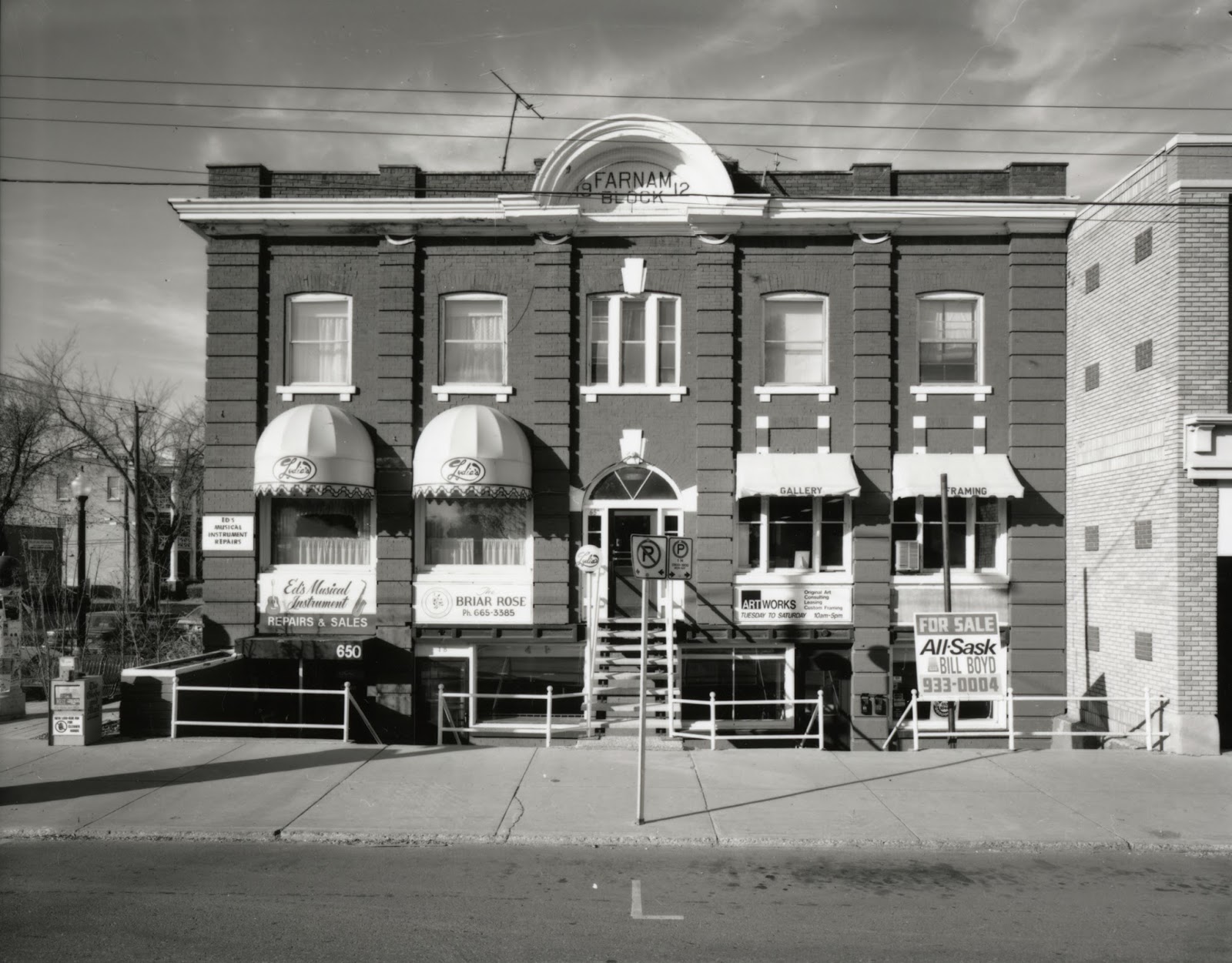
courtesy Saskatoon Public Library – Local History Room
A coffee house in Saskatoon was not only not a crazy idea, but it was an entertainment concept perfectly in tune with the era. A tradition of live music in coffee houses had been established in the city since the beginning of the 1960s. In 1962 the Louis Riel Coffee House at 725 Broadway Avenue opened its doors to folk music aficionados. It was owned by Colin Holliday-Scott and managed by William Golf. In its three years of existence, it hosted such acts as the New Christy Minstrels, Sonny Terry & Brownie McGhee, and Shawn Phillips as well as local artists like Louise Gadzala and the Pawns, and The Nomads. Joan Anderson (shortly to be known as Joni Mitchell) gave her first paid performance here on October 31, 1962, and made a few appearances in both 1963 and 1964. Larry Gelmon was a regular attendee:
I remember it well — it opened when I was in high school on the site of a former Public Library on Broadway. I went there many times, partly because I was an incipient folkie, partly because it was an opportunity to hear live folk music, partly because it was a place where one could mix with what passed for “beatniks” in Saskatoon in 1963-65 (meaning university students who could grow a beard), and mainly because going there in high school was a way of showing girls how cool you were. Unfortunately the girls I was trying to impress didn’t realize the significance! I don’t remember who I saw play… but it was on the Western Canadian folk club circuit, which included the 4D coffee house in Regina.
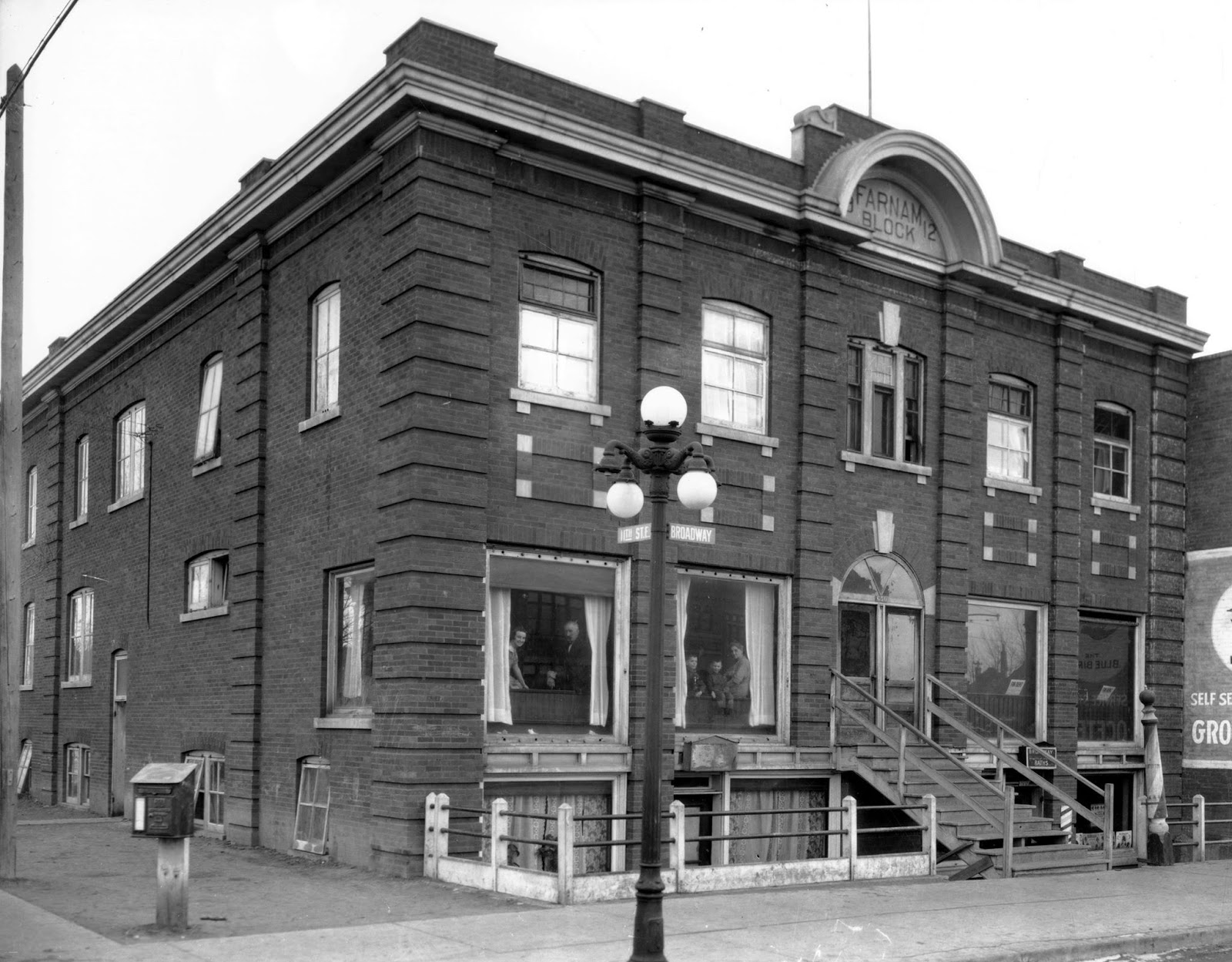
The Shadrack Coffee House materialized in downtown Saskatoon in the autumn of 1968. It seems to have started with pretensions to a European atmosphere – one Saskatonian confirmed that he went there to “…meet up with French speaking people.” However it appears that it was merely an unfinished thrift store basement with a capacity of perhaps 40-50 patrons. The Shadrack received a masterfully written negative review in The Sheaf (the newspaper of the University of Saskatchewan student’s union) in October:
Shadrack, being a coffeehouse with very little and very poor coffee, is the new concept in boredom presently inhabiting the basement of the Opportunity Shop (Second Avenue – rear entrance please). Here students who are too unambitious or impoverished to find interesting weekend diversions may sit and smoke and cultivate their apathy in the company of other unambitious, impoverished students. For a mere twenty-five cents, clients exchange the satisfaction of grinding cigarette butts on the floor and the possibility of listening to second-class entertainers.
The biblical Shadrack was a young man who survived being thrown into a fire by the Babylonian King Nebuchadnezzar, so perhaps the name was appropriate for the tortuous experience. It lasted only a few sad months.
The Bessborough Hotel started its coffee house (which was not really a coffee house as it served mostly alcoholic drinks) in 1969. It took the original concept of an intimate room with either a beat poet or an acoustic folksinger protesting against injustice or war, and turned it into what suspiciously appeared to be a normal loud nightclub with bands. The Star-Phoenix introduced it in January of that year:
The coffee shop at The Bessborough will be opened to the young set on Friday nights after 9 a.m. The first in a series of discotheque shows will be this Friday, with The Kaleidoscope as the featured band. There will be a cover charge and the facilities will be open to those in the over-21 age group since limited refreshments will be available.
And of course there was also the Cellar Club at the University of Saskatchewan, located on the lower floor of the Memorial Union Building on campus. It had been going every Sunday evening since the 1964 “Hootenanies,” and one of the devotees was a University of Saskatchewan student named Barry Singer. He had music in his blood – he had played trombone in a band at his high school – Walter Murray Collegiate – and frequented the Louis Riel Coffee House where he loved its atmosphere. He realized that he was not cut out to be a professional musician, but continued to hang out with them.
Singer was known as an open-minded, outspoken social activist and counter-culture figure even then. Mairi Maclean recalls:
One thing I absolutely remember about Barry is …he and several friends lived in an apartment on top of the Bay Parkade downtown across from the old Bay on 2nd Ave… (I think) Barry was in law school. It was the time of student revolt, Students for a Democratic Society, etc. The Black Panthers came to campus to talk to students, as did comedian/activist Dick Gregory. But the memory is about surveillance. A mountie (plain clothes) would sit in a vehicle on the top of the Bay Parkade for hours at a time to keep an eye on Barry’s place. We all thought it was hilarious – couldn’t he be doing something more productive???
To counter this perceived earnestness, Singer fortunately had a pronounced sense of humour. He is remembered by his friend Thom Teed:
Barry was a great guy… he had a great sense of humor and was always laughing and chuckling and, due to running a head shop around the corner from the Crypt, irreverent. He was very aware of poverty issues and social justice, and always had good quips to illustrate his points.
Popular music was in the air of Saskatoon in that summer of 1970. The movie Woodstock started playing in July at the new Midtown Plaza Cinema to daily sold out crowds. That same month, the rock festival on rails – known as The Festival Express – was making its way across Canada via the Canadian National Railway. Staged by Eaton-Walker Associates, it started in Toronto on June 27-28, continued on to Winnipeg for Canada Day, and ended in Calgary on July 4-5. Many Saskatonians travelled either to Winnipeg or Calgary (or both) to take in the impressive array of talent which included Ian & Sylvia, Janis Joplin, The Band, the Flying Burrito Brothers, Buddy Guy, Mountain, and the Grateful Dead. The train stopped in Saskatoon for several hours – there were no performances, but as is seen in the 2003 documentary film Festival Express, a number of the participants made a liquor run to refresh their stocks.
A Saskatoon version of Woodstock called Woodtick was organized by Gerry Stoll of the University of Saskatchewan Students Union and Dave Tkachuk of Actron Agencies. It was held on August 16 in a field sixteen miles southwest of Saskatoon on the highway to Pike Lake. The Woodtick lineup included Calgary’s Gainsborough Gallery, Ottawa’s Samsara, three groups from Regina The Flying Colours, Mudd, and the Andantes; and finally, three groups from Saskatoon The Skip Kutz Sextet, Shadow Fax, and Witness. A total of 2,000 people attended and “except for a little beer and a few would be gate crashers”, it was a peaceful affair. Overall Saskatonians were developing a serious hunger for live rock, folk, and even fusion music.
The club scene in Saskatoon in 1970 was encouraging in one way and discouraging in another. The lowering of the drinking age that year gave rise to several new nightclubs as more and younger potential customers looked for musical entertainment as they imbibed. To the already existing Red Lion on 22nd Street managed by Bob Matovich, and the Imperial Room at the King George Hotel was now added Don Yip’s Diamond Head Room at the Executive Hotel in June, Fred Assaly’s Embers in July, and Sid and Jean Woo’s Marigold in October. They all featured live music which should have resulted in a choice for customers of a variety of rock, jazz and folk talent. Such was not the case however.
The prevailing view of club managers was that any act doing original material was not worth hiring. Ned Powers, entertainment writer for the Star-Phoenix, addressed this in his year end summary of the 1970 Saskatoon entertainment scene:
Some Saskatoon musicians claim they are being denied chances. One act made the point in a recent press release. The fact is the act in question has had two lounge opportunities but didn’t attract big enough followings to suggest a re-hiring.
He then made his key observation:
More Saskatoon musicians might get work if they would conform to the music demands of the public. The Society of Four, the Belmonts, The Brass Mint and The Bar Six are examples of groups who are thoroughly enjoyed by Saskatoon crowds. The lesson today is that nightclub audiences come from an age group which wants to hear a steady beat of familiar tunes.
Thus the club managers made the decision to hire mostly middle-of-the road lounge acts and cover bands that would do faithful renditions of standards and well-known, sometimes mindless, pop hits of the day. It was a safe and thoroughly sensible business decision – they satisfied most of their customers and made a profit. While this emphasis on cover tunes was by no means limited to Saskatoon clubs, the unwavering compliance of the clubs put a definite chill on originality or creativity from local musicians who desired to play in them.
Barry Singer had a different vision and a different audience in mind. He thought Saskatoon needed a more open-minded venue – not a club that featured middle of the road, middle aged, Vegas-type acts, but one that was hip to underground and alternative music. He thus became the driving force behind the establishment of the Crypt Coffee House.
His first major decision was to determine the location of this proposed haven of originality. The new club was to be smack in the middle of what some Saskatonians badly wanted to be their own Greenwich Village. Some even tried to call it “The Village”, but they were kept in check with a healthy dose of mockery from their peers. A bohemian commercial community had slowly established itself along the three blocks of Broadway Avenue between 12th Street (then and still known as Five Corners) and Main Street. It included Hanna’s Organ and Piano Studio, the aging Broadway Theatre which at the time was not above showing risqué films, the slightly sleazy Saskatoon Sauna and Massage, Swanee’s Beauty Salon, and eating establishments like the Drop Inn Lunch and Launderette, the Broadway Bakery, the Broadway Café, and Pinocchio’s Pizza. As well there was the aging but still attractive Victoria Elementary School, and several small, attractive apartment blocks that had seen better days.
People contributed to the atmosphere too. A cheerful, heavy-set, defrocked monk (or so the story goes) by the name of Cliff Stanischuk sold marijuana and LSD to interested clients, while teenager Thom Teed (with a headband no less!) sold issues of the ultra-hip alternative culture newspaper Georgia Straight on the street on the weekends. It could not have been an easy first job in the Broadway ‘hood:
My friend Richard and I got called into the office and warned by our grade school principal about selling the ‘Georgia Straight’ anywhere near the school grounds. I guess he thought it was subversive…. And all my ID was noted by the RCMP in Saskatoon because the FLQ Manifesto was printed in the ‘Georgia Straight’… .
There was also the youth Drop In Centre at 1009 Broadway which had been established in the fall of 1969. Its mandate was to help keep youth occupied, out of trouble, and in many cases away from “conflict-laden home life.” Its activities included high school tutoring, group discussion, reading, films, art classes, ping pong and weiner roasts. The centre also dealt with bad drug trips, accommodating homeless teens in the homes of nearby volunteers, and made referrals to welfare agencies. Along most of the side streets off Broadway, university students occupied small, dingy basement or stuffy attic lodgings carved out of the older houses. Most were musically aware or curious, and both students and stray teens needed somewhere to go in the evenings.
The Broadway North neighbourhood became truly hip (or – depending on one’s point of view – went badly “downhill”) in September 1969 when Michael “Bear” Miller and Michael Taylor of the band Humphrey & the Dumptrucks moved into the Merry Mansion – a small two-storey house at 525 – 11th Street E. They would be joined shortly by the other two members Graeme Card and Gary Walsh (better known as Humphrey Dumptruck). The Dumptrucks had first come together after a chance meeting at the 1967 Blackstrap Folk Festival and, with an ever-changing lineup, had intermittently performed in the intervening years. The four most constant members named above decided to make their association a bit more formal. Many considered this lineup to have been their strongest, and in the summer of 1970 Card and Taylor in particular were in an extremely active period of songwriting. They were literally churning out what would shortly be the hits on their first album such as “Man From the City”, “Calgary Song”, “Send Me Some Word” and “Clyde Beattie.”
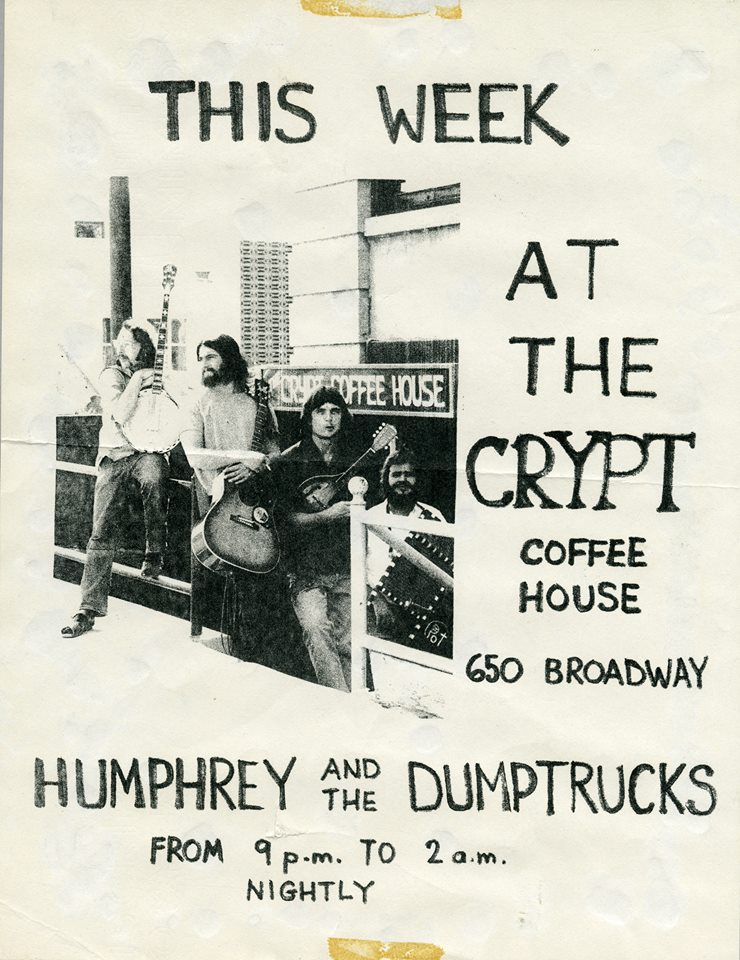
courtesy Saskatoon Public Library – Local History Room
As well they had recorded a multi-song transcription session for CBC Radio in June, and performed at the Saskachimo grandstand show to considerable acclaim in July. They were not necessarily popular with their neighbours as they liked to party (loudly) into the wee hours, and they frequently enjoyed outdoor jam sessions at the Merry Mansion. When these gatherings took place at night, they would usually involve a huge bonfire in a pit in the front lawn and the widescale inhalation of the herbal jazz cigarette.
Due to their gregarious and amiable natures, and their urge to play throughout the prairie region, they had cultivated an extensive network of fellow musicians, many of whom would bunk in with the band as they were passing through Saskatoon on their way east or west. Inadvertently at first, then deliberately, the Dumptrucks acted as a conduit between touring artists and the new coffee house.
An ideal location for a club was found in the Farnam Block at 650 Broadway on the northwest corner of 11th Street, a combined residential/business block built in 1912 (and regrettably demolished in 2015). The two upper floors were living quarters of various sizes and layouts. One apartment had been turned into a business – a unique venture known as The Blown Mind. This was Saskatoon’s first headshop, owned by Bohdan Prociuk, and staffed by musician Allan “Toad“ Jasper (of Toad and the Tadpoles fame). The bottom floor – accessible by two stairwells leading down from the sidewalk – was reserved for commercial spaces. “Nick the Barber” operated a popular tonsorial parlour – the Nutana Barber Shop – since time immemorial, but he was mystified at the drastic downturn in business as the new denizens of Broadway rarely got their hair cut. Next to him was a used university textbook store. At the north end Barry Singer and his partner Judy Deverell had already established the Sol Store in 1968. It sold psychedelic and black light posters, jewelry, incense and the hippest of clothing. Its stream-of-conciousness advertisements touched on all topics relevant to its patrons (and thus did not really need to make sense):
Sol Store is chills spills mad dogs mao tao wow rock and roll Conspiracy monkey business kali easy rider hard times spare dimes phone taps first step Stonehenge solstice Alcatraz right on Georgia straight.
At the south end of the basement level was Lyle’s House of Sound, a vendor of radios and stereos since 1969. That unit – approximately 1,750 square feet, was initially fitted out as a restaurant according to a 1912 blueprint in the City of Saskatoon Archives. After 1925 it became the original premises of the Gibson Photo studio, darkroom and photo-finishing lab. By 1970 Lyle’s was floundering, and the space was in the process of becoming available. Singer recalls how he acquired his “silent partner”:
Lyle’s House of Sound was the business of Lyle Wallace. Lyle was looking to close down the stereo store (I didn’t know at the time that he was a big time fraud artist who liked to sell things but never really paid for his stock), and he asked me if I would like to take over his lease. After some discussion a deal was made. Lyle would let us take his lease, he would put up the capital to renovate and furnish, and I would do all the work getting the place set up and operating the coffee house. Of course I later learned that there would not have been any trouble getting his lease, as the owner Bob Davidson (who was a working musician and a friend of the coffee house) was owed thousands by Lyle.
And – serendipitously – the residence of the Dumptrucks was just behind the Farnam Block, barely a one minute walk to the side door of the building.
All these social, geographic and ideological factors came together when the Crypt opened its doors to customers in August 1970. An optimistic article appeared in the Saskatoon Commentator entitled “New Coffee House Hopes to Fill Entertainment Gap”:
The entertainment scene in Saskatoon is far from adequate, lacking both a place where entertainment is youth-oriented and a place where people can enjoy entertainment without having to drink. That, at least is the opinion of moustached and mutton-chopped Barry Singer, who plans to open a coffee house with live entertainment at 650 Broadway Ave., Monday Aug. 17…. Tentative plans are to open from 9 p.m. to 2 a.m. Monday through Saturday with a $1 cover charge going almost entirely towards entertainment fees. Whatever money the coffee house makes itself will come from the sale of sandwiches, pizzas and hopefully a variety of coffees and teas, says Mr. Singer.
Singer was clear about his target clientele:
… he said he hoped that persons of various age groups would feel at home in the coffee house, though he expected it would primarily attract those in the 16-30 years age range. He said he felt it would be more suitable for young people than a bar.
The name Crypt connoted dark, subterranean and atmospheric – possibly dangerous and certainly a bit mysterious. Writer Larry Gelmon recalls the space: “…was dark, smoky, rarely crowded, and felt very much like an “underground” club — perhaps being in the basement was a feature. It wasn’t very big, which lent it an intimacy.” Attendee Rob Robinson remembers: “It was a pretty cool atmosphere though, down in the bottom of the Farnam Block with the Blown Mind headshop upstairs. It had the dark mysterious lighting of what you would expect a coffee house to have…The stage was small but very close to the tables.” Another regular, Gerry Wall, recalled: “… the Crypt as being (in this order) down stone stairs, dark (maybe going through a curtained doorway?), smoke-filled with little round tables covered in tablecloths adorned with straw-wrapped Chianti bottle candle lamps. The seats were almost unbearably uncomfortable. Incredibly thrilling place for a 16 year old!”
There has also been some speculation from aged local hipsters that the name was a direct steal from the Postcrypt Coffee House in New York City. That establishment had been founded by Rev. John Cannon in 1964 in the basement of St. Paul’s Chapel on the campus of Columbia University. However since very few people outside of Columbia University had heard of it, it likely was not an inspiration.
Barry Singer recalls a less romantic reason for the name:
Nothing cryptic about it. It was in a basement, the place always was kind of dingy. But the real reason for the name was that we inherited from Lyle’s House of Sound a large oval shaped sign that rotated wonderfully outside the place. After fiddling around with various names, The Crypt just looked right inside that oval. At the time, to be honest, I didn’t know what a crypt was – i.e. a place to put dead people, I just liked the sound of the name and the fact there were none of the usual vowels in it.
The key words then were dark, and below street level, as all the best counter-culture and musical clubs have traditionally been. For many Saskatonians with big imaginations, this was going to be their Cavern Club. The décor was – as one would hope – sort of tomb-like, but also funky, and still very Saskatchewan. On one wall was a large mural of classical columns and arches which was supposed to make the room look ancient. Singer recalls the furnishings:
Church pews were used only because I was able to get them for free from the Synagogue that was closing on the west side. The tables were made by welding discs from farm equipment to poles that were screwed on to round pieces of plywood. Any decoration was done by friends volunteering to paint, and any posters that were up just came from stock in the Sol Store.
The stage was small and crowded, stuck in a corner, and less than a foot off the floor. A huge poster of two hypnotic cat’s eyes was affixed to the wall behind the performers. Officially capable of accommodating 100 persons, it made room at a moment’s notice for many more when the occasion called for it.
Singer initially wanted the establishment to be known for its food. An advertisement in The Sheaf read: “At the Crypt Coffee House, the coffee is incredible, the pizza is delicious and the sandwiches are fantastic.” This clearly exaggerated its appeal. The food offered from the kitchen was straightforward and simple fare – ham, corned beef and turkey buns. Pizzas were available, but unknown to most of the patrons the staff would take an order, then phone Pinocchio’s Pizza down the block, and minutes later walk down to bring it back and present it on a plate.
While Singer’s first choice of beverages was alcoholic, he did not waste time trying to secure a license. He insists: “a liquor license was thought to be impossible to get in those days, so we never even tried.” The cold beverages then had to be “special.” They included all the normal soft drinks, but also offered a variation whereby fruit flavoured syrups were mixed in – i.e. a Cherry Cola or a Lemon Sprite. These glucose monstrosities predated Big Gulps and the Slurpees. The warm beverages included a variety of teas and coffees. This was well before the era of Starbucks, so the specialty coffees were unique and sometimes scary. The “Mocha” simply had Nestle’s instant hot chocolate poured into the brewing pot, while the “Turkish” offering had three packets of coffee (instead of the already strong single packet) to make it thick and viscous, and a lemon thrown in for bitterness. Gut-wrenching as it was, surprisingly few complaints were ever received.
License or no license, several cartons of beer were quietly kept under the counter of the kitchen for the performers and special friends of the management. One of the dishwashers – then only 12 years of age – recalls being terrified (but not wanting to show it) at least once an evening when the Broadway Avenue beat cop would drop down for a friendly chat and lean on that very counter. He was convinced he would hustled into a waiting police car and driven straight to Prince Albert Penitentiary.
Singer hired three servers in August – Judy Coburn, Norma Sim, and Rick Dawson. Later in the fall he would also hire a fourth – Kelly Marble, already an inhabitant of the Farnam Block. Gerry Wall recalls: …” Rick Dawson…played drums… he had a frizzy head of hair and a constant smile. Instantly likeable! Kelly Marble (as I recall) was perpetually high, and more or less set the tone for the club.”
To oversee the operation of the kitchen, Singer hired University of Saskatchewan student Lee Silversides. He was a most unlikely and unqualified candidate for any kind of culinary position (and indeed he immediately hired two teenage helpers to actually prepare all the food and do the dishes). However he brought to the Crypt unique added value. He resided in and was the building manager of the Farnam Block, so that hopefully ensured that any building problems would get priority treatment. He also hosted a late night radio program on the University of Saskatchewan’s CJUS called “Grooveyard” (where he could talk up the club) and had built up an enviable knowledge of popular music. He was close friends with a large number of local musicians and could likely reel them in to perform.
Most advantageously though was the fact that he was the Music Director of the University of Saskatchewan Students Union, and was starting to book important musical acts from eastern Canada and the United States. The Sheaf trumpeted some of these in their August 7th issue:
In other music news it appears that at long last Saskatoon may find a niche for itself on the North American musical map. Music Director Lee Silversides has tentatively booked two well-known groups, Country Joe and the Fish and James and the Good Brothers for Frosh Week. CJ and the Fish from San Francisco need little introduction after their Woodstock movie appearance. James and the Good Brothers are a Toronto band, who recently toured on the financially disastrous Maclean- Hunter Transcontinental Rock festival….
Singer wanted to piggyback some of the Crypt engagements on Silversides’ U. of S. bookings where possible. Multiple gigs would obviously be more likely to attract outside name bands to Saskatoon.
Although the food and staff deserve more than a passing mention, it was music that was the raison d’etre of the Crypt, and it was the music that people came to experience. It was wide-ranging and appealed to many tastes. There was folk, folk-country, traditional jazz, heavy jazz, straight ahead rock, jug band, as well as some weird and hard to define music. By his choice of bookings Singer discouraged musical conformity, and he strongly encouraged the artists and bands to perform their own tunes. Most of them were at the start of their professional careers, and were trying out their acts for the first time. In the Commentator interview Singer stressed:
The keynote will be variety, but with a considerable emphasis on youth- oriented genres. Well-known local jazz-rock band the Skip Kutz Quartet will be featured on opening week, followed by a sitar player from India and guitarist Keith Bartlett the second week. Other bookings in the coming weeks include Moose Jaw pop ensemble The Mozart Group and Toronto group “James and the Good Brothers.” Mr. Singer says if the coffee house is successful he hopes to bring in entertainment from outside Western Canada at least once a month. He even thinks wistfully of Leonard Cohen and Joni Mitchell – but then recalls that the going rate for Joni is $10,000 a day.
Singer felt that word of mouth would bring in all the customers he would need. And, aside from a few select paid advertisements in the city’s main newspaper Star-Phoenix and the university paper The Sheaf, he stuck to his guns for several months. The key – as he and all club owners knew – was to get their acts mentioned in local entertainment critic Ned Powers’ weekly Saturday column “Sight and Sounds.” To ensure that meant always reserving the best seat in the house gratis, and supplying a beverage or two for him. Powers honoured the unspoken deal, and in turn regularly included references to final night Crypt performances and “coming next week” names.
The exciting opening week was given over to Singer’s childhood friend Skip Kutz and his Sextet. That ensemble consisted of Kutz (bass), Randy Shaw (trumpet), Torch David (tenor sax), Terry Kennedy (guitar), and Andy Petterson (drums). And it frequently became the Septet when they were joined by vocalist Mairi Maclean. Kutz was the son of the dapper and urbane Barney Kutz, a jazz and classical bassist of considerable renown. Skip’s band had been formed back in 1967 while he was studying at the University of Saskatchewan, and had had a surprisingly stable lineup since. For part of that first summer they were known as The Bohemians – seemingly a name that referred to their lifestyles – but in actuality was a blatant commercial plug. Recalls Kutz:
We were hired by Molson’s Breweries (MB bought Sick’s Bohemian) for a 10 week tour of the province to commemorate Canada’s Centennial. We played off the back of a modified three ton truck all over Saskatchewan including Urainium City. We were accompanied by Dave Balon (NY Rangers), George Reed (Roughriders) and Molson’s reps. Fine art it wasn’t…but a great gig with free booze, vehicles, and lower level intercourse… the verbal kind.
Musically though, the Sextet were groundbreakers – the only band in town that played a sophisticated jazz-rock-latin fusion. And even though they were loud and electric, they were careful to distinguish themselves from rock bands. As Kutz laughs “we played what people thought they should like!” And they were extremely popular. Constantly booked to play formal dances and graduations, they also gigged at the occasional club like Donavon’s on 8th Street, and the King’s Hotel in Regina. They even played the regional rock festivals such as the Qu’Appelle Rock Festival in June 1970, and Woodtick in August.
Maclean recalls that the gigs available to them directly influenced their repertoire:
…the set lists of the Skip Kutz aggregation reflected the multi-faceted requirements of a “dance band” working to get as many gigs as it could in 1970. There were many audiences to be served in a university town with a large variety of students from different faculties, and lots of functions through the year requiring music – from frosh week concerts outdoors on the quadrangle, to faculty dances (it was the age when every faculty had a “queen”, as in arts queen, and a dance was required to announce said queen) to final graduations in spring. There were also folk and jazz gigs on campus, many at the old MUB (Memorial Union Building) basement venue. And there was a new kind of pop gig, too, part of the new wave of music “festivals” sweeping across North America, beginning with Monterey Pop in 1967 and the Seattle Pop Festival and Woodstock in the summer of 1969. And of course it was the age of the coffee house, and Barry Singer’s place was a prime example.
Their repertoire included unusual tunes such as “Watermelon Man” by Herbie Hancock, and “A Foggy Day” – a standard originally done by Fred Astaire, then by Ella Fitzgerald and most recently by Charles Mingus. Like all good jazzers they did odd arrangements and sometimes indulged in extended improvisation. Maclean fills out the list:
In the realm of jazz, we played a lot of older standards (“Satin Doll” would be a good example) as well as jazz of the period for ensembles with horns, including tunes by Cannonball Adderley, songs like “Work Song”, “Canteloupe Island” and so on. The Bossa Nova, a new latino beat from South America and the amazing Antonio Carlos Jobim, had captured North American ears beginning in the mid-1960s with the big hit “Girl from Ipanema” and I remember singing a lot of bossas (“One Note Samba”, “Corcovado”) and many by Chris Montez (“The More I See You”; “Call Me”), as well as tunes that could be “latinized” like “A Taste of Honey.”. We chose certain songs from the hit parade that suited our needs – “Windmills of Your Mind” from the (then) new movie The Thomas Crowne Affair and “Alfie”, by the movie of the same name; tunes by chart toppers Burt Bacharach (“I’ll Never Fall in Love Again”; “The Look of Love”) and the horn band Blood Sweat & Tears (“Spinning Wheel”). Rock and blues were also on the list, from “Hey Joe” by Hendrix to Neil Young’s “Southern Man.”
Maclean stood out with her interpretation of several standards including “Killing Me Softly.” A reviewer from June of 1970 wrote of her: “Mairi Maclean sings in a deep, mellow almost serpentine voice. Every once in a while, when the lyrics are good, and the melody is good, little bubbles seem to rise from the depths of her song. Which is an interesting effect.”
She recalls of the Crypt gig:
I remember performing a strange, trance-like extended arrangement of The Stones’ “Paint It Black”, and I distinctly remember wearing a daring suede mini skirt and boots of Spanish leather… I absolutely remember the aptly named dark, subterranean space. Very low ceiling and crowded with small tables. And of course, it was just out the back door to the notorious Merry Mansion of Humphrey & the Dumptrucks.
Andy Petterson adds: “What I remember well about that night was that everyone smoked like chimneys, and that you couldn’t see the back of the room.” As for the music: “it has faded from my head. It was loud as I recall – I just remember frantic bass and drum solos.”
The Skip Kutz Sextet/Septet were a smash. They played to standing-room-only crowds, and an impressive in-concert photograph of the Sextet on stage was published in the Friday August 21st edition of the Star-Phoenix.
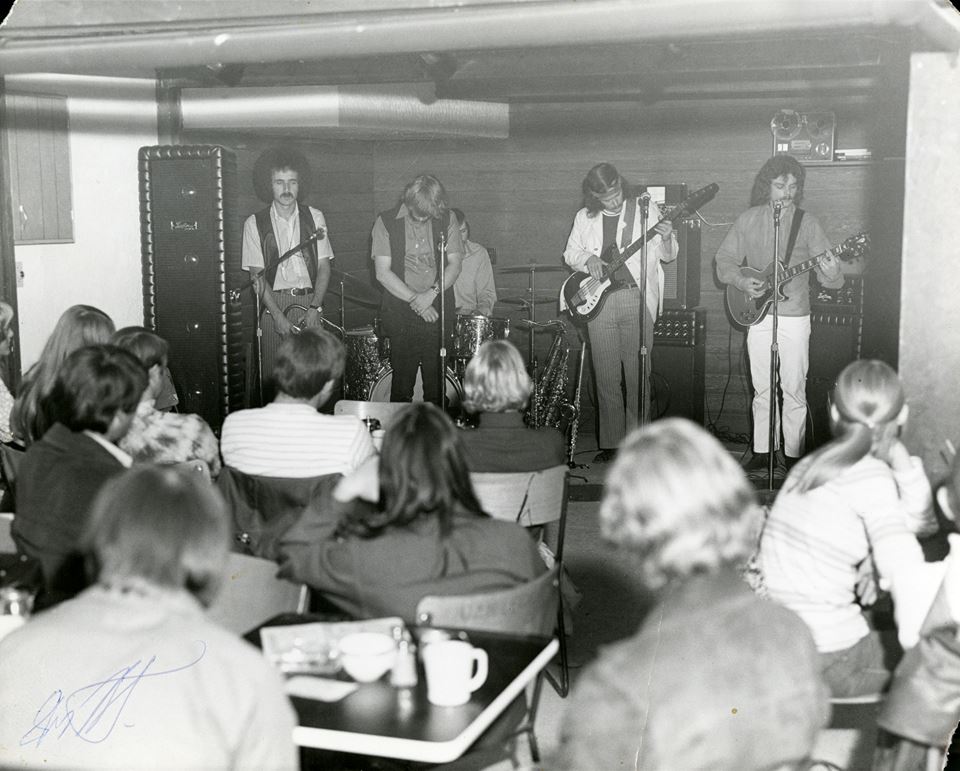
courtesy Saskatoon Public Library – Local History Room
Coincidentally their stay at the Crypt was also their farewell to Saskatoon. The band had already made the decision to move to Vancouver, and they did so barely two weeks after their Crypt date. They were feeling restless and wanted to make the transition from a weekend band to a full-time professional band. As well they were starting to witness audience saturation in their home province.
The second week’s entertainment was a touch more surreal. Keith Bartlett – guitarist for the seminal 1960s Saskatoon band Louise Gadzala & the Pawns – agreed to provide the entertainment. Between bands at that time, he recalls:
…I came back from Toronto and was sleeping on the floor of the Merry Mansion (the Dumptruck Residence). This was not a particularly happy time for me as my marriage had ended while I was in Toronto [where I was] spending time with Lenny Breau, playing with Jack Lenz and Gordon Stobbe, and I was between knowing where to be or what to do …
I remember that I was preceded onstage at the Crypt by Rick Dawson doing his stand-up routine .. “I come from Arelee”.. ha ha…. and…I played the saw (bent over my knee) with a fiddle bow, and did a rather vaudeville version of “Amazing Grace”… Michael Taylor and Humphrey accompanied me, and Michael pulled the blindfold from my eyes on the last line of “was blind but now I see”…
It is possible that drugs may have been involved. Ned Powers had no clue how to describe him: in his column all he could write was that he was a “guitar specialist.” The audience was also bewildered, yet thoroughly entertained. Even Bartlett is mystified about his performance:
This is strange to recall now, because it wasn’t my “thing” to do this, and it wasn’t really “my act”, either … (I didn’t really have an “act” at that moment in time). But as June Carter says, in ‘Walk the Line’, “I just learned to be funny so that I would have something to offer.”
The third week welcomed a newcomer to Saskatoon – Paul Hann from Edmonton – who would make his first Crypt appearance to almost empty houses. Powers introduced him “Paul Hann is a folk singer, originally from England, who is working regularly out of Vancouver and Edmonton and appears headed for bright things.”
Hann recalls his beginnings:
I did start singing in England in a folk group at a church youth club. I came over in 1967 to Edmonton, and started working at Woodwards Food Floor. There I met Pete White who wrote lyrics for songs. It was the start of many years together writing songs. My first gig in Edmonton was at Giuseppe’s Pizza Cellar…they were big on having folk music. Then… there was a folk club at the YMCA run by my good friend Steve Gosse. We played together for a while…But …it was because of the Dumptrucks that I came to Saskatoon…We were all buddies.
White reinforces that:
Saskatoon was always a high point for us because it had its own unique spirit, and of course because of the Crypt, but mostly because of the Dumptrucks who became our friends. We always got drunk and stoned together, and I admired both Graham and Michael as songwriters (I still think “The Summer Clyde Beatty Came to Town” should have been a classic.
As for this first Crypt gig, Hann’s memories are hazy:
I do remember playing the coffee house, but you have to bear in mind those were crazy times, we all probably lost a few brain cells back then. It must have been one of my first trips to Saskatoon. I always loved visiting the city to see Humphrey and the Dumptrucks. It wouldn’t have been part of a tour, but definitely one of my first out of town gigs where I’m sure I would have tried out some of the new songs Pete and I wrote together as we only started writing around that time.
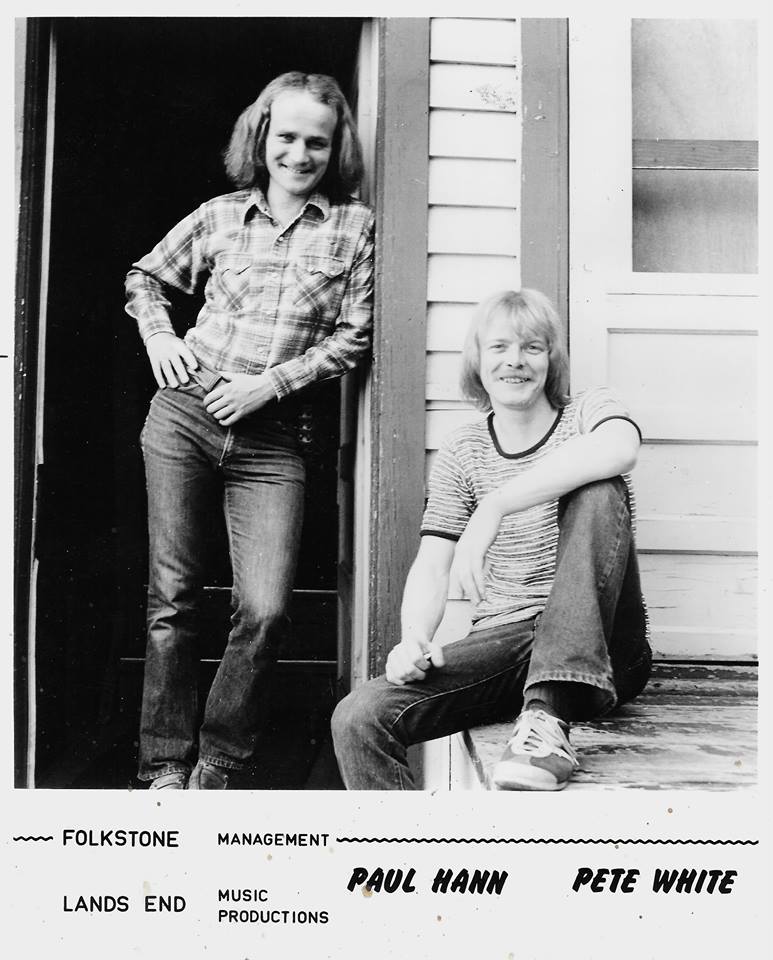
courtesy Pete White
Honest to God rock music took over the Crypt from September 7-12 with the appearance of Jalal. It had formed out of the ruins of Mozart and the Wolfgang, founded in Moose Jaw in 1965. By the spring of 1966, they were far and away the most popular group in southern Saskatchewan, and were part of a live broadcast every Thursday night on CHAB from Temple Gardens. They were known for their extremely long hair, and even R.P.M. Magazine noted that they were “Canada’s Most Repulsive Band.” They could not have paid for better publicity – and so they embraced their notoriety.
The band relocated to Saskatoon in 1967 and shortened their name to just The Mozart Group. Larry Brown, Garry Brown and Rodney Konopaki were all alumni of that legendary band. Moose Javians they definitely were, but yokels they were not. For much of 1968 they lived and worked in Toronto and Montreal. They played at the Night Owl in Yorkville, and at the Montreal International Pop Festival in July 1968 with The Who, The Haunted, Ohio Express, Andy Kim, and Mitch Ryder & the Detroit Wheels. They had even managed their own below-street level club known as Sister Rae’s in the Montreal suburb of St. Laurent well into 1969 before coming back to Saskatoon.
That fall they returned to Saskatoon, with both Garry Brown and Rodney Konopaki taking up residence in – where else – the Farnam Block. They added Eston-born Jack Lenz on keyboards in July 1970. He had come to the attention of local music lovers playing first with the Pawns, then with The Great Flood, and occasionally guesting with the Skip Kutz Sextet. The new formation had also roughly coincided with their adoption of the Baha’i religion which, because few understood what it meant, rendered the band infinitely more exotic. Thus to their solid electric blues foundation was added an overlay of spiritual awakening, as reflected in their name change to Jalal which is one of the months in the Baha’i Calendar (it translates as Glory)
For the previous two months they had been writing and rehearsing both original and cover material while their booking agent was assembling a cross-country tour lasting seven months. The Crypt gigs were to be their official “showcase” as a new band, as well as the last public “rehearsals” prior to starting the big tour. Not only were the band members pumped, but their fans were anxiously waiting for their debut.
They clearly did not disappoint – either in their performance, or in their tasteful and eclectic choice of material. Larry Brown recalls that:
Our repertoire…included: “The Fool” by Quicksilver Messenger Service; “Kings and Queens” by Renaissance, a group founded by Keith Relf – former singer for the Yardbirds and his sister Jane. (Renaissance was a folk/classical rock group); “Walk on Gilded Splinters” by Dr. John … I recall with that one we encouraged, and obtained, a lot of audience participation … might have gone on for half an hour or more; a lot of blues material (I can’t for the life of me remember all of the artists/songs, but I do recall the Paul Butterfield Blues Band because I was playing a lot of harp); “Sister Ray” by the Velvet Underground; our own arrangement of a Bella Bartok composition; some original songs, such as “War and Peace” (half an hour long), “Song to Seraphim”, and others …
Three crowd-pleasers he forgets to mention were Paul Butterfield’s “Get Out of My Life Woman”, and the set-opener “I Feel Good” by James Brown. It captured the audience’s attention as the club would be in total darkness for several minutes, one of the band members would give a James Brown scream, and all the stage lights would come on at once. Another ground-breaking performance was their version of the Steve Miller Blues Band’s “Children of the Future” where, for the introductory instrumental passages they turned on a television set behind drummer Rodney. Recalls Larry Brown “… it [was] part of an early attempt at multi-media frenzy…”
Garry Brown recalls one evocative story:
… just before we played the song “Lucille” from the Everly Brothers I told a story of a girl I had dated once in Moose Jaw whose name was Lucille, and how one night I had gone to her cabin at the lake when her family was there, and in the middle of the night as I was running towards her cabin I ran into a barbed wire gate and the posts at either end broke off and hit me in the back of the head. Then her father came out of the cabin with a gun and I went running along the shore of the lake to escape. My hair was silver at the time because I had just played a Halloween gig at Temple Gardens in Moose Jaw before getting inspired to head out to the lake and look for her cabin. When the story was done and the night was over, that same Lucille came up to the stage with her husband. I hadn’t realized she was in the audience!
It was an exciting transition period. Jalal were performing the best of both of their worlds: they were still enjoying doing older rock tunes and extended blues numbers, and were starting to incorporate their new sophisticated material.
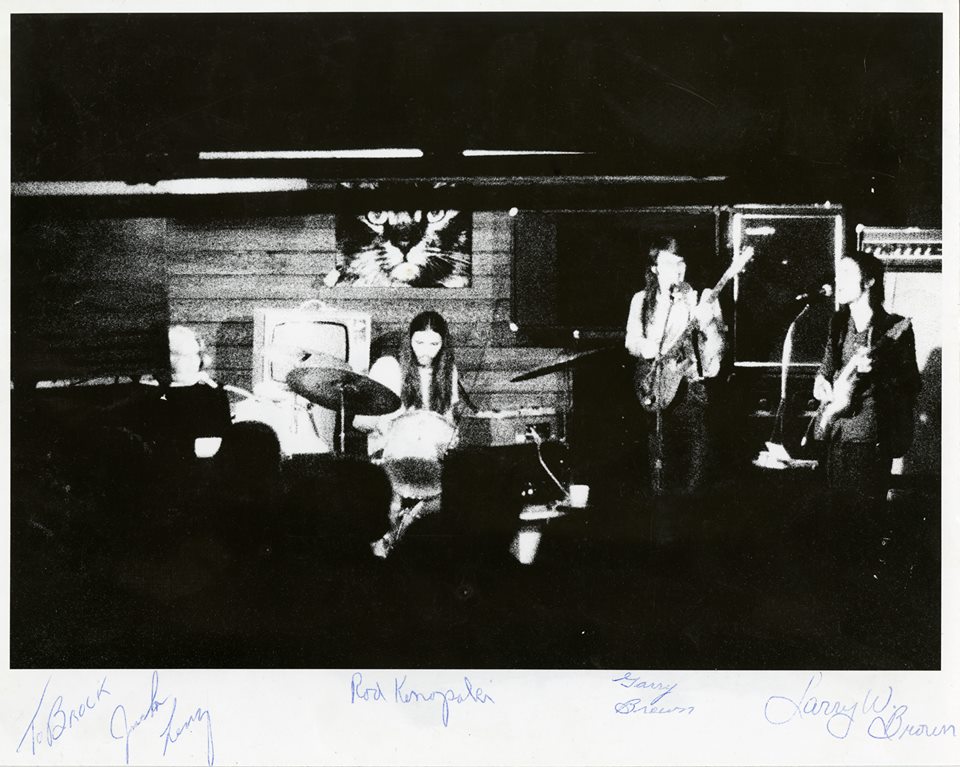
courtesy Saskatoon Public Library – Local History Room
One of the most popular draws of The Crypt’s entire existence was the trio James and the Good Brothers, who appeared the week of September 15th. Formed by the late James Ackroyd, Bruce Good and Brian Good – all of Richmond Hill, ON – in March of 1970, the trio were on the verge of a major break-out. Their first gig was opening for Bonnie and Delaney & Friends (a good fit) and Grand Funk Railroad (a not-so-good fit) at Maple Leaf Gardens on April 3, 1970. They also managed to get seats on the Festival Express train which traveled across Canada during July. Just before heading west, they had played three nights (September 10-12th) at the legendary Riverboat in Yorkville. Although their repertoire was more folk at the time, there was no mistaking the countryish influences bubbling under for which they would later become better known.
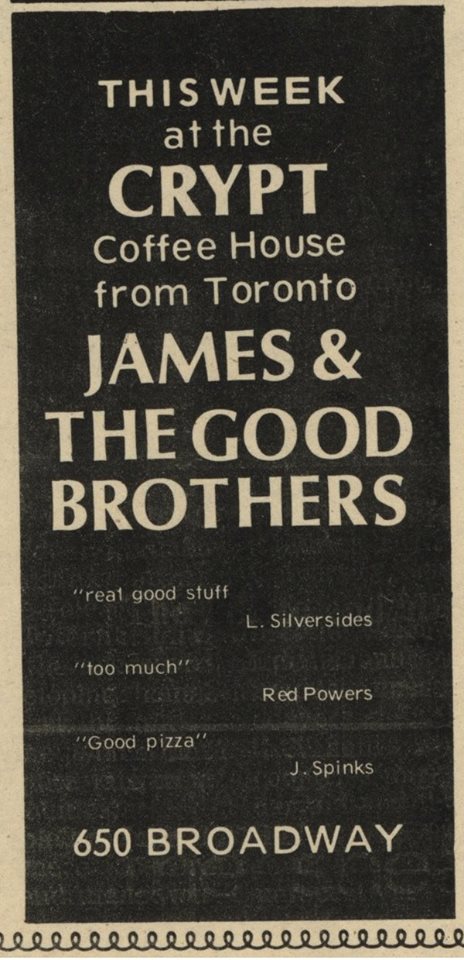
courtesy University of Saskatchewan Archives
The threesome looked unusual on stage – with the two very tall and very long-haired Good twins flanking the smaller Ackroyd. The three traded jokes, smart-ass remarks and lead vocals – usually on the songs they had each written. Bruce sang “Poppa Took the Bottle from the Shelf” and “No You Can’t Help Yourself,” Brian sang “Talk About the Good Times” and “At Dawn,” and James sang “Ecks” and “Oh How She Rides”. In addition to their original tunes, they also did several covers including Harry Nilsson’s “Rainmaker”, and Blind Faith’s acoustic gem “Can’t Find My Way Home.” Ackroyd tried to describe their style:
Our music is back porch. Not this slick country twang stuff. We don’t do that. Ours is easy, acoustic and country – with some other stuff mixed in. There are shades of rock. And there’s a bunch of Canadian things in there that probably no one knows about.
They were favorably profiled by Susan Jasper in the Star-Phoenix. She gives notice of her musical preferences right away:
There’s always been a great, vacant gap in entertainment for young people in this part of the country – occasionally rock groups put in an appearance, but the sweet sounds of folk-rock, country and bluegrass are seldom heard. This situation has been remedied this week by three Toronto freaks called James and the Good Brothers, filling the Crypt Coffee House on Broadway to capacity. They’ll be there until Saturday night.
She then tried to explain their music:
James Ackroyd and twin brothers Brian and Bruce Good put out a spirited and free-wheeling sound that belies the fact they’ve been together only since February. They describe themselves as one rock guitarist and two bluegrass, Irish folk song fans who met in the Penny Farthing in Toronto’s Yorkville village, and managed to rub off on each other to their mutual benefit. And benefit it has been, as you can tell by the names of groups they perform with – Bonnie and Delaney, Sly and the Family Stone, an upcoming Led Zeppelin date, and the crew of the Festival Express that played this summer in Toronto, Winnipeg and Calgary.
She continues:
Prior to coming to Saskatoon, they played in Toronto’s Riverboat club, the bastion of folk music in Canada. And according to Bruce, the newly- opened Crypt club is a good, logical follow-up, similar to the Riverboat and one of the few clubs that don’t rely on booze and amplified rock sounds to draw crowds. James and Co. need no amplifiers to tell their story. Two guitars and an autoharp do it for them. Their penchant for jam sessions late at night has afflicted James with laryngitis, but they expect to have all three voices working collectively this weekend. James, Bruce and Brian are a thoroughly engaging trio, who rap freely with the audience, and obviously dig each other and their music. It’s got something to do with good feelings coming from a band that feels it belongs together.
She touches on Ackroyd’s previous connection to Saskatoon “James is a rather dazzling guitarist no stranger to Saskatoon where he performed six years ago with Barry Ennis and the Keymen, and three years ago with The Knack at the Esquire Club.”
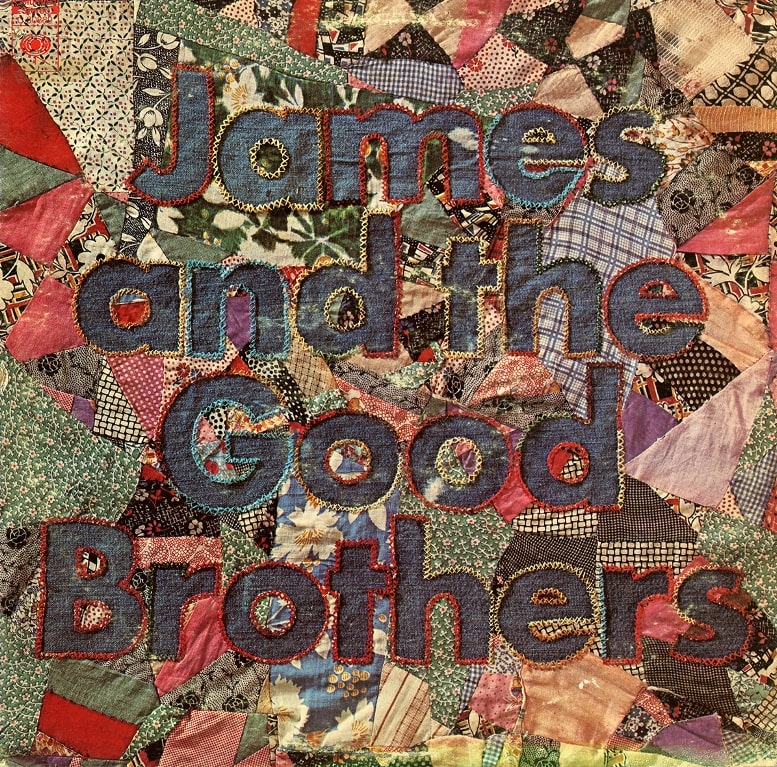
Then it was back to the Goods:
Bruce and Brian write a lot of material, Brian has been leading with a gently, drawling voice, punctuated by droll cracks from Bruce. They seem happiest with Band music like The Night They Drove Old Dixie Down, but can range from Joe Cocker lyrics to Merle Haggard’s bad joke Okie from Muskogee. Their music will be sweet indeed to starving folk fans – it has the feeling of folk music with the spirit of rocking bluegrass.
She finished with: “… they’re just plain, good folks, friendly people with friendly music.”
During their run, they were accompanied by Humphrey Dumptruck. He recalls:
James and the Good Brothers were in Saskatoon for a gig at the Crypt and asked me to sit in on banjo for a session as their younger brother Larry was unavailable. The only tune I recall was “Fox on the Run”, a signature of theirs.
Larry Gelmon remembers other things:
One of my highlights was the sojourn there of James and the Good Brothers – who Lee and I saw at the Festival Express concerts in Winnipeg and Calgary in June-July 1970 and convinced Barry to book. They came to Saskatoon with their manager Ken Walker (the co-producer of the Festival Express), and on the last night of their gig there was a very wild party at Norma’s [Sim] apartment, culminating in their manager Ken passing out in the bedroom and being abused by “Bear” Miller of the Dumptrucks of being an Eastern scum and not being able to keep up with Prairie drinkers/smokers!
Lee Silversides adds details to that picture:
… closing night …. party at Norma’s….Michael Miller (Dumptruck) and Kenny Walker (Mgr.- J.& GBs) splitting a tab of very powerful LSD that rendered them semi-comatose. They were laid together on a bed in another room where they remained unmoving for the rest of the party.
Who would be at such a party?…. the Dumptrucks, Larry Gelmon, Alan Shectman, Norma, Barry Singer, his girlfriend Judy, and a bunch of others that are just a blur …. funny how your brain filters out the excess without you even realizing it. Nevertheless, what I can remember, I remember fondly.
And Barry Singer with yet another point of view:
Hanging around, after hours with…I think the Good Brothers, trying to show them how cool we all were in Saskatoon. Someone from ‘The Sheaf’ or CJUS had interviewed them, and their whole staff showed up as well. It was a good party….
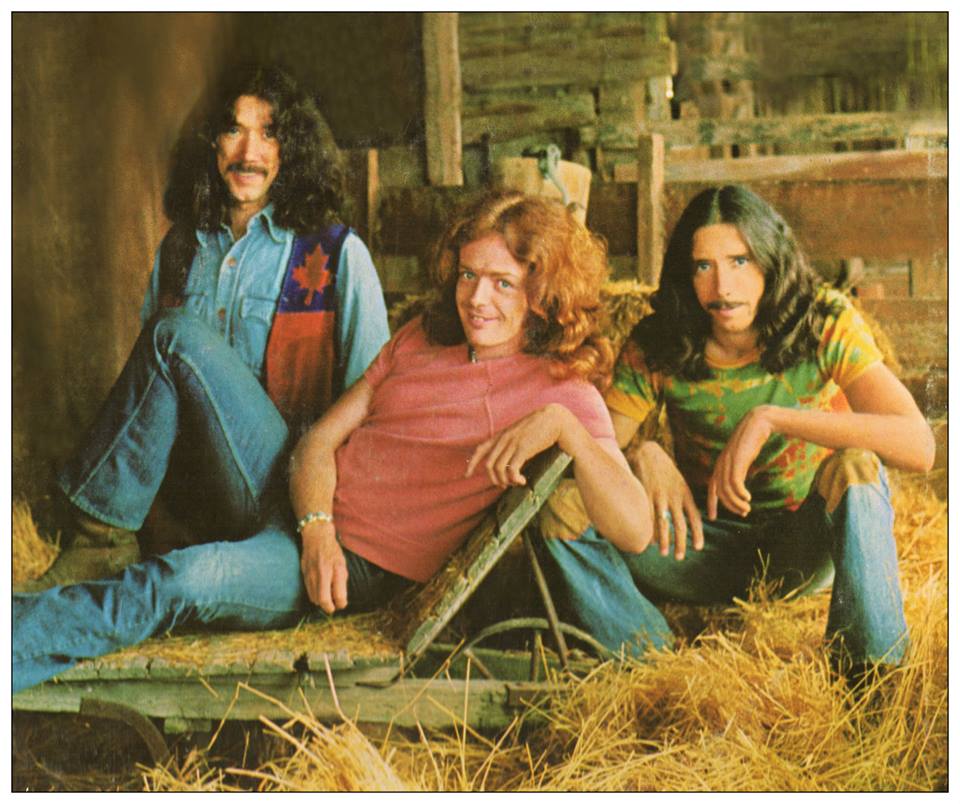
The contacts the Goods made on the Festival Express train would help them place an all-important foot in the door of the U.S. west coast music scene. Indeed the following year they would move to San Francisco, play at the Fillmore West and the Troubadour, and open for the Jefferson Airplane, the Quicksilver Messenger Service and the New Riders of the Purple Sage. They also recorded their one and only album for Columbia Records at the Alembic Studio in 1971 with members of the Grateful Dead and the Jefferson Airplane guesting on the sessions.
Ackroyd left the group in 1973, and the Good Brothers went on to a long and illustrious career. They produced sixteen popular albums from Pretty Ain’t Good Enough (1977) to Live n’ Kickin’ (1983) to Deliverin’ the Goods (1986) to Live Fast Love Hard (1990) to Blind Faith (2006) to Restricted Goods (2008). They earned eight Juno awards, and continue to perform in both large and small venues.
Due to popular demand (and a free week in their schedule), Jalal returned for their second run at the Crypt from September 21-26th They continued to awe both the audiences and the reviewers. Larry Gelmon of the The Sheaf wrote a lengthy review on September 22 of one of their performances:
Today instead of the record reviews of which this column sometimes consists, I’d like to tell you what is happening this week at the Crypt Coffeehouse, Saskatoon’s newest live entertainment club (I’m tempted to say Saskatoon’s only live entertainment spot, but that is unfair.) What makes the Crypt unique is that the music is of paramount importance, and is not just background noise for the customer’s drinking and carousing. And the music is worth listening to.
He went on to highlight “This week has seen the return to the Crypt of a new group – JALAL. Jalal is easily the most exciting and interesting group that has been seen in Saskatoon in a long, long time.”
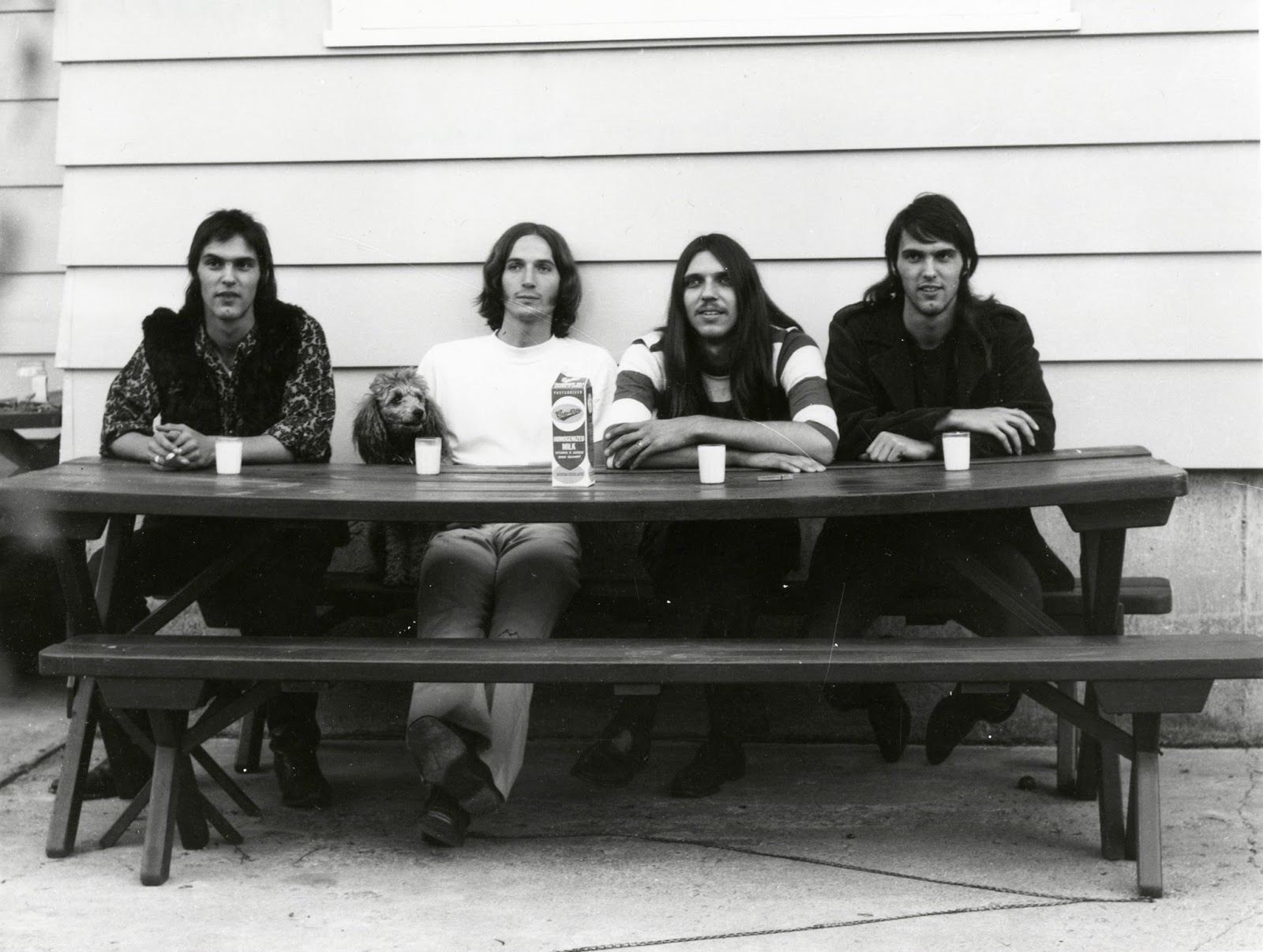
courtesy Saskatoon Public Library – Local History Room
He recited the band’s history going back to the days of the Mozart Group and explained their recent conversion to the Ba’hai way of life. Then it was back to the music:
Much of Jalal’s music can only be described as “Spiritual”. But that is not to say that listening to Jalal is like being in church. Far from it. The musicians in Jalal are just that – musicians, and they bring to their music years of training and playing in country music, rock, blues, jazz, classical, and who knows what other musical fields. Having been together only a month and a half, it is amazing to hear them – they are tight, they are musically exciting, and they are as close to mastering their instruments as any young musicians could realistically hope to be (that’s a pretty heavy thing to say, but that is the feeling I get listening to them).
He pulled himself up:
This is starting to sound like a super-hype, but facts are facts. On the Monday night two weeks ago, when they debuted, I saw some local musicians, people who have been playing for years, sitting in the audience shaking their heads in wonder. One older musician said they were too musically perfect to have a wide appeal. But see for yourself. They will be at the Crypt all this week. That is, go and see them if you want to listen… .
Jalal had been electric and heavy – so in order to broaden the palette, Singer opted to go in another direction with his next series of bookings. Again Gelmon commented in his Sheaf column:
After a week of amplified music, the Crypt goes acoustic this week with five days of folk and jugband music. Of interest is the fact that there are several different performers doing their respective things. Last night saw Al Bond and Steve Carter performing. Tonight (Tuesday) John Briscoe is in attendance. Wednesday night Ron Dixen will demonstrate his talent, and for the rest of the week it’s the National Washboard & Co. from Regina. They are a jugband type group, and have a couple of females in the group for a little added interest. As well, there will be other as yet unnamed folksingers from around the province supplementing the already mentioned performers.
The National Washboard & Co. was yet another Dumptruck connection. Leader Bob Evans recalls his early inspirations and how the band was formed:
In February 1969 a friend and I went to the first Regina Folk Festival out at the University of Regina. We were Grade 9 rock and rollers playing all the standard garage band rock of the day (“Wipeout” – yikes! that was still relatively recent at the time!), “Heatwave”, “House of the Rising Sun”, etc as well as Cream, Steppenwolf, Hendrix, yadda yadda yadda) Didn’t know what folk music was, but the festival was at the university so that made it uber cool and appealing to high school students like us. The first night of the festival was one of those life changing moments for me. Within the first hour I was captivated and by the end of the week- end I knew that acoustic music was it for me – and that’s been my focus ever since.
He continues:
Humphrey & the Dumptrucks opened the festival each of the three nights. We were gobsmacked. We had never heard anything like them. Five string banjo – “Foggy Mountain Breakdown” – washtub bass – washboard – jug band music – Beatles songs – original tunes – goofy outfits – blues – bluegrass – kazoos! It was a whole new world of music.
The next year we took more friends with us to the festival and once again everyone was blown away by the Dumptrucks, as a well as the John Paul Juke Band from Winnipeg. That weekend (sometime in March 1970) we decided to form a jug band of our own – The National Washboard & Company, named after the maker of the Georgina’s washboard – The National Washboard Co. (well duh!) For the remainder of high school we eschewed the call of rock and roll for the glamour of jug band and folk music. We started playing every chance we got – church coffeehouses, old folks homes, banquets. Looking back it’s interesting how much work we were able to get coming out of the gate.
The members of the band were Georgina Betts (washboard and comb), Craig Mahood (guitar and kazoo), Barb McKell (washtub bass and jug), Bob Rodgers (guitar), and Evans (banjo and mandolin). Each of them took turns singing – and Betts and McKell exhibited a particular talent for harmonies.
The summer of 1970 rolled around and The National Washboard & Co. were invited to play at the Regina Exhibition. A meeting they had fervently wished for finally took place:
…we got to meet the Dumptrucks when they were playing at the same venue as us. It wasn’t quite like meeting the Beatles, but they were the hippest people we had met in our short musical career, and in retrospect became our gateway to the world of folk music. A few weeks later we decided to drive up to Saskatoon and check out the Merry Mansion. We drove up unannounced only to find The Dumptrucks weren’t in, but someone staying there invited us in for tea. I believe that was when we somehow met the guy running the Crypt (Barry something?). Anyway, he booked us without hearing us, but I believe he had heard about us via the Dumptrucks when they encountered us at the Regina Exhibition. As I recall we were booked for Thanksgiving weekend 1970.
Evans emphasizes:
This was a HUGE deal for us. As I mentioned, we had played around Regina a lot. But The Crypt was the first REAL coffeehouse we were going to play at – and it was out of town! This was the BIG TIME as far as we were concerned. We were all 16 and 17 years old and only had two drivers licenses amongst us. We drove up to Saskatoon with a whack of friends packed into a borrowed van. (We got stopped around Lumsden by the RCMP and had to explain ourselves – I mean 11 kids packed in a van – and ensure that none of us were runaways).
Their performances did not initially set the audiences on fire:
I remember it as a three night engagement – Thursday, Friday and Saturday…One problem was that we had to play three sets a night. We didn’t have that much material. So in preparation we had to learn a whack of tunes and break them all in that first night. It did not go well… It was one of the worst experiences of my life. Hardly anyone there and we played absolutely awful. I’m pretty sure the owner wanted to fire us. In fact, he made us come in and rehearse the next afternoon. Second night went better, but still not a lot of people. But the last night was packed and we had a great time. I think we managed to redeem ourselves.
The band was enthusiastic, but musically rough, and their repertoire was nothing if not interesting. Their crowd pleaser was undoubtedly Country Joe & The Fish’s “Fixin’ to Die Rag.” It had featured prominently in the recent Woodstock movie, and did after all include the ultimate profane word spelled out letter by letter. As Evans recalls: “we usually used it as a show closer.” They also played “Washington at Valley Forge,” “Coney Island Washboard,” “If You’re a Viper” and many songs off of the first two Jim Kweskin and the Jug Band albums. Other tunes included the Dumptruck’s “Merry Mansion Quadrology” (which obviously went over well in Saskatoon), and “I Think I’m Losing My Marbles” by Mendelson Joe. Again Evans remembers: “… actually any song that was ragtimey and had any hint of drugs was fair game….when cramming for the Crypt I know we all did one song solo… I did John Sebastian’s “Younger Generation.” “I’ll be Your Baby Tonight” is one I remember that fell completely apart on that first night. “San Francisco Bay Blues” was another we crammed.”
His chief memory of The Crypt:
Mainly it was narrow, dark, dark, dark, with dim lights (red?) and thick smoke – I loved it!!! I remember sitting there in the dimness looking through the haze of smoke and thinking to myself, “This is exactly where I want to be.” I’d slit my wrists today, but back then it was EXACTLY what I wanted to do (sit in a smoke filled room, that is).
National Washboard & Co. lasted about a year. Evans then started a notable solo career, and shortly acquired an enviable reputation as a fingerstyle guitarist. His first recording was the eponymous LP released in 1975 on Colly Records. He was also included in the 1976 various artists album entitled Prairie Grass, Prairie Sky: Music from Saskatchewan on Carragana Records.
The other unnamed folksinger in the advertisement turned out to be Gord Pendelton – a last minute but very popular booking. Pendelton had only recently gone solo – he had been an integral part of several Saskatoon rock bands since 1965 including Rik and the Ravens, The Warloks, and Renaissance. His latest group effort was fronting Jr. & Dudley Dean, with whom he had had a falling out only a couple of months before.
He recalls:
I played the Crypt several times I think the winter of 70/71… it was Lee who booked me in there… It was a very cool place, very Crypt-like, that and the Cellar Club at the U of S … It was your typical coffee house – tables, chairs, I think even table cloths! … I was doing a lot of Gordon Lightfoot, James Taylor and Cat Stevens.
Comfortable with all genres of music, his folksinging style was particularly smooth. A reviewer wrote: “This week the guitar and voice of Gord Pendleton melts across the tables. A noticeable James Taylor influence pervades, and he offers a lot of his self-penned songs in his smooth-flowing manner.”
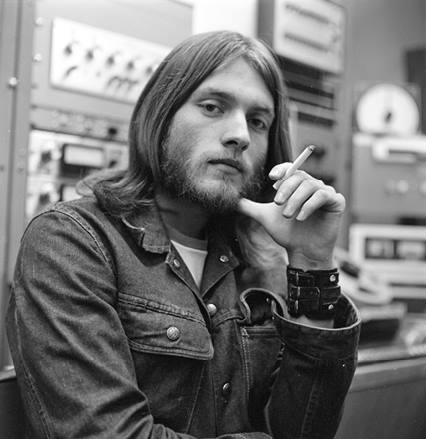
courtesy Jim Tustian
Due to his fine showing at the Crypt, he soon after signed a contract with Humphrey and the Dumptrucks’ manager Allen Shectman. In January 1971 Pendleton went into Tom Northcott’s Studio 3 in Vancouver where he recorded two self-penned tracks “After You’d Gone” and “Used Up All My Rainy Days.” While he waited for Shectman to secure a label contract, he also recorded two additional original songs at Century 21 Studio in Winnipeg – “So Glad You Came Around” and “Find A Way.” He picked one song from each session to grace his debut single on Boot Records in 1972.
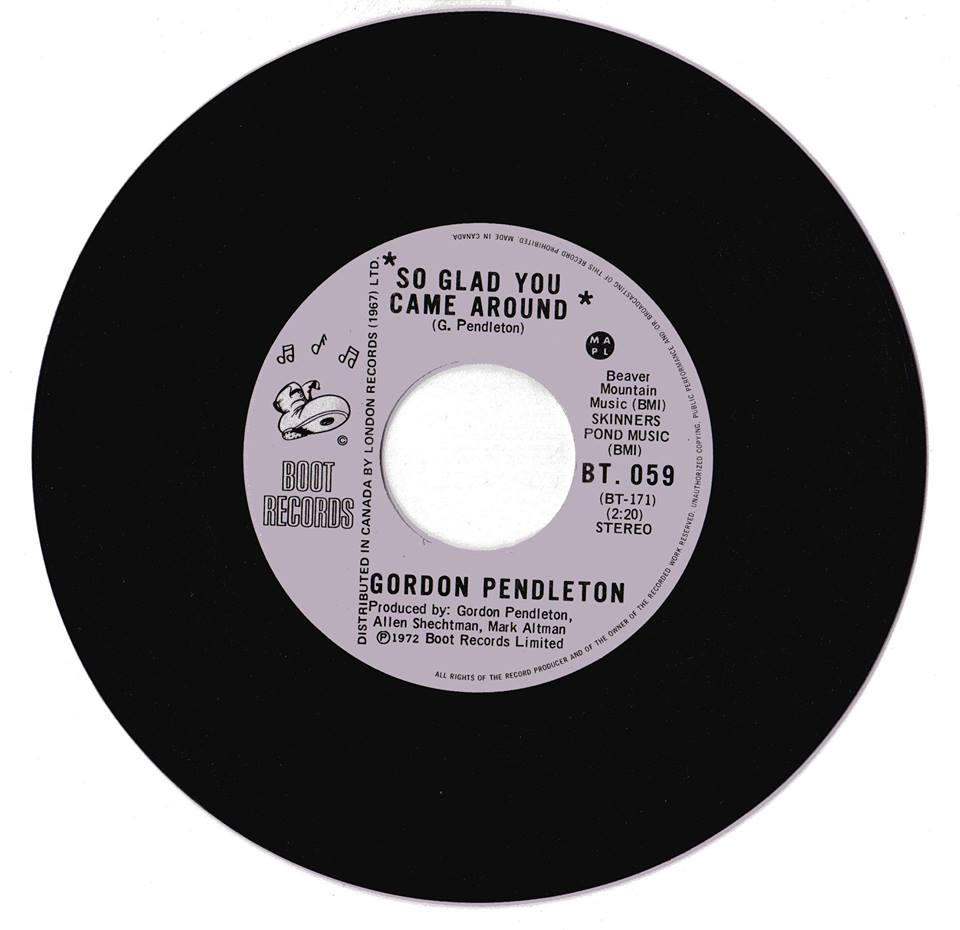
Folk music continued in the following week (October 7-10th) in the person of a new young singer/songwriter Alan Rhody. Rhody was an American from Louisville, Kentucky then living in Vancouver. Music had been an overwhelming part-time interest since 1966 – but as a trained graphic artist his day job was working in retail advertising for Simpson Sears.
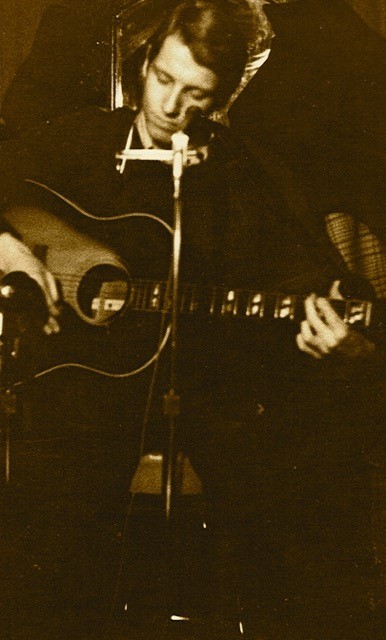
courtesy Alan Rhody
While taking part in a folk-singing contest at the Bunkhouse Coffee House in Gastown in 1969, Rhody was befriended by Russell Thornberry. Thornberry – singer/songwriter and host of the CFRN television program Music ’70 – encouraged him and featured him several times on the Edmonton-based program. Rhody recalls Thornberry phoning him in late summer 1970:
He asked how serious I was about my music. I said very serious. He said I had to make some choices about how much time I devoted to it. Then he said he had a gig lined up at the Crypt Coffee House in Saskatoon, but could not make it due to scheduling difficulties with his program. “Can you do it instead? They will fly you there, pay for your hotel…” I said yes immediately.
He recalls that it was an important gig for him:
I remember the manager treated me very well and stuck to the agreement I had… I remember that it was fairly dark in there. And though every night wasn’t a large turnout, there were two evenings that made it all worthwhile. I’m thinking it was 3 or 4 nights, maybe Wed. – Sat. but not a week. I was a little nervous.
His Saturday night crowd was unusually small – but it was not his fault. The Centennial Auditorium featured Pink Floyd that evening, and they turned out to be a slightly more magnetic draw. Rhody’s repertoire included several original songs “I had only written maybe four or five songs that I liked well enough to perform” including “Stranger in the Street”, “Cathy From Ohio” and “My Kentucky.” He also recalls covering Gordon Lightfoot’s “Ribbon of Darkness“, “Early Morning Rain” and “Sixteen Miles,” as well as Ian & Sylvia’s “Marlborough Street Blues.” He continues:
At any rate, I felt good about my shows there and that was very important to me at that time because it was my first “real” gig. I’m not sure they knew that, but Barry certainly didn’t seem displeased with my show or my music. …All I had played up to that point were a few open stages and a few nights back home in Kentucky where I first stepped on a stage. There would be two acts on the bill and we’d split the tips. And in Vancouver where my family and I were living in 1970, a couple church folk gatherings and some pizza places I want to say was over in West Vancouver. They gave me free food and allowed me to collect tips…
His several days in Saskatoon resulted in another break:
I was having breakfast or lunch in the restaurant of the hotel, and I noticed a bunch of young guys who looked like they could be musicians, so I went and introduced myself. It turned out to be Holger Petersen and the band he was managing, Manna. We became pretty good friends, and later Holger invited me onto his radio show. Holger also took me to a friend’s house in Saskatoon, and told me to listen to a new album – it was Joni Mitchell’s ‘Blue’. It was great…that changed a lot for me!
The Crypt experience was nothing but positive for the neophyte Rhody. He would shortly go into music full-time, would move first to Toronto where he appeared on the television programs The Performers and the Ian Tyson Show, then onto Nashville. He would go on to a lengthy and successful career, both as a touring and recording artist, but also as a Nashville-based songwriter. His compositions would be covered by Suzy Boguss, Murray McLauchlan, Lee Greenwood, Tanya Tucker, Toby Keith, the Atlanta Rhythm Section, Oak Ridge Boys, Billy “Crash” Craddock, Lynn Anderson, Michael Martin Murphy, Hoyt Axton, Del McCoury, Ronnie Prophet, Ricky Van Shelton, Lorrie Morgan, and George Jones.
Another set of local rockers who owned the stage from October 12 to 17 were Jr. & Dudley Dean. Founded as the Pig Bristle Brush Blues Band in 1966, they split and reformed numerous times as band members tried their chops with other ensembles. They reformed again in June 1969 and after a period of calling themselves The Cornerstones, renamed themselves after the authors of an obscure 1963 western novel Gun Shy (by Les Savage Jr. & Dudley Dean). They had recently lost some members – namely the aforementioned Gord Pendleton who had struck out on his own as a folksinger, and guitarist Cal Poole. The core lineup then of this oddly named band included Malcolm Buchanan and Bob Silversides on dual keyboards and vocals, Tom Cunningham on drums, and Terry Crockett on bass. Without a traditional frontman, the band could have been static and unexciting. However Silversides and Buchanan refused to sit behind their respective keyboards – they were constantly on their feet, frequently switched instruments, and played each others parts. A big topic amongst their followers was which one was Jr. and which one was Dudley Dean?
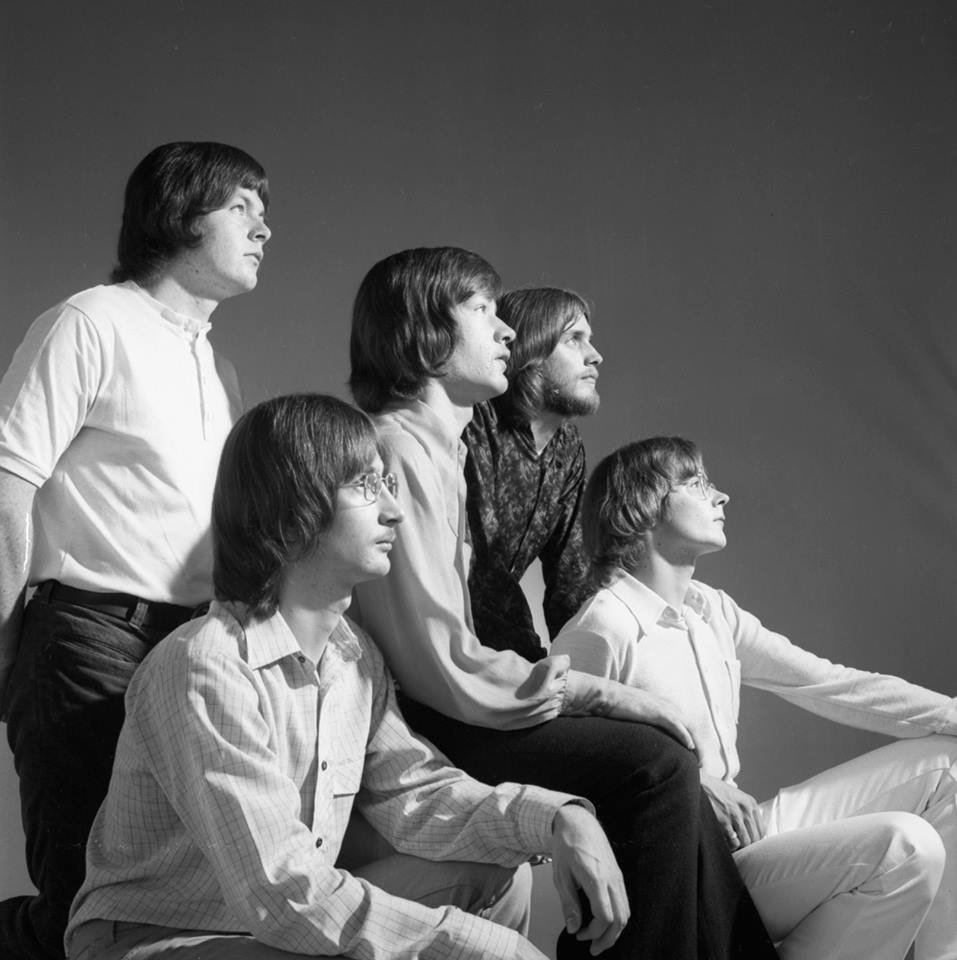
courtesy Saskatoon Public Library – Local History Room
Audiences were starting to notice the band. The Star-Phoenix featured them in an article entitled “Saskatoon rock quartet ready to be discovered” in the September 26th 1970 issue:
Jr. and Dudley Dean are approaching rock music in a progressive, imagin- ative manner. The four Saskatonians have left out what has become an integral part of most groups: the lead guitar. They more than compensate for this by using two keyboards.
Bob Silversides handles the organ chores adeptly, his nimble fingers jumping about, constantly caressing the key[s] in the driving, expressive manner peculiar to accomplished musicians. Filling in for the absent guitar is an electric piano played by Malcolm Buchanan. He adequately transposes even the most difficult of guitar riffs to suit his instrument.
Providing the solid beat is Tom Cunningham on drums and Terry Crockett on bass. While Silversides and Buchanan are flying about on the keyboards, they supply a touch of hardness. Silversides mentioned they were reaching towards a “rhythmical and melodic” sound. Presently they are easily fulfilling this task in fine fashion.
They were chiefly a cover band – but a very intense album-oriented and early progressive cover band, miles away from anything resembling the western connotations of their name. They shone with versions of “Green-Eyed Lady” (Sugarloaf), “Honky Tonk Women” (Rolling Stones), “See My Way” (by the Jethro Tull off-shoot Blodwyn Pig), “Evil Ways” by Santana, and “I’ve Seen All Good People” (Yes).
They had had a very busy summer playing festivals in the Qu’Appelle Valley, and at North Battleford, Winnipeg, and Lake Metigoshe on the Manitoba-North Dakota border. As well they had been booked into several week-long engagements at the King’s Hotel in Regina. As the Star-Phoenix writer explained: “Finances play a major part in any group’s existence, and it is for this reason that they became primarily a club band. But although club crowds are more of a challenge to play for, they would rather play dances.”
Drummer Tom Cunningham recalls the Crypt gigs well:
Well, the place was long and narrow – dark with tacky stage lighting. I think we added a few of our own lights. It sounded pretty good in there even though the wall across from us couldn’t have been more the 20 ft. away. I thought the band was pretty good. We rehearsed a lot. We had a good work ethic and we wanted to be good….Most of the bands back then took their work seriously and worked very hard, consistently. I had the opportunity to grow up around very good musicians and the discipline thing rubbed off… Doug Rusu, guitar player from A Group Called Mudd [from Regina] sat in for one or two sets. The audiences as I recall were receptive and enjoyed the music and the club.
That same Star-Phoenix writer opined “Jr. and Dudley Dean are full of ambition, and the members have been in music so long that persistence is another of their virtues…” and then summed up with “Their unique keyboard arrangement may offer them an excellent chance for making it in the rock field, which lately has become overpopulated by groups that all sound alike.”
By 1971 Jr. and Dudley Dean’s manager Lorne Horning was negotiating with GRT Records and they started planning their first album. They received considerable press when they opened for their new label-mates Lighthouse at the Centennial Auditorium on March 24 when the Toronto band toured Canada in support of their new album One Fine Morning. Susan Jasper somewhat awkwardly worded her note that Jr. & Dudley Dean were “…a very noticeable Saskatoon group, which according to pianist Malcolm Buchanan should be recording on the GRT album when it opens its studio in Edmonton this spring.”
The studio in question was actually Tommy Banks’ Century II Studios, and R.P.M. magazine announced the three-way deal with the studio, the record label and the band in August 1971. Jr. & Dudley Dean did indeed put a full album on tape, but it was never released. That stopped them in their upward progress, and they dissolved in April 1972.
Cunningham had already left to become a founding member of Saskatoon’s first “power trio” Trina with Greg Delaronde and Brian Plummer. Bob Silversides soon after joined Rik and the Ravens for the summer of 1972, then moved on to the Society of Four (where he was of course the fifth member). Malcolm Buchanan re-engaged with Cunningham in Trina (where he became the fourth member of a three member band – only in Saskatoon…?), and then moved to Toronto in 1975 to play keyboards for Aerial.
The third week of October saw the previously-mentioned band Manna from Edmonton take the stage. They were an unusual act which included Larry Reese (vocals, guitar), Jan Randall (keyboards), Chuck Carson (keyboards), Tom Cairns (drums) and Bev Ross. They did not do any cover songs – instead they wrote their own compositions such as “The Wizard”, “In a Japanese Garden”, “Uncle Clarence’s Piano”, “Snazz” and “John Hammer.” Recalls vocalist Bev Ross:
We were all pretty excited about Manna, fresh out of high school, having postponed further education to see how far the band would take us. All five of us were writing material, so by that time we had easily enough original stuff for an hour and a half of songs, probably in two or three sets at the Crypt.
Eclectic folk-rock is one descriptor for Manna’s music. Chuck Carson was writing into roots Americana (The Band), Larry Reese wrote folk- rock ballads & anthems (early Jefferson Airplane?), Jan Randall was exploring piano-based singer-songwriter stuff (early days in that genre: Randy Newman), Tom Cairns was much into Frank Zappa and The Who and I was writing, on piano, British folk-derived rock-tinged stuff (Pentangle, Incredible String Band). And when we collaborated, as we sometimes did on tunes, we’d get everything from British music hall-style comedy songs to bigger ballads and wizard rock.
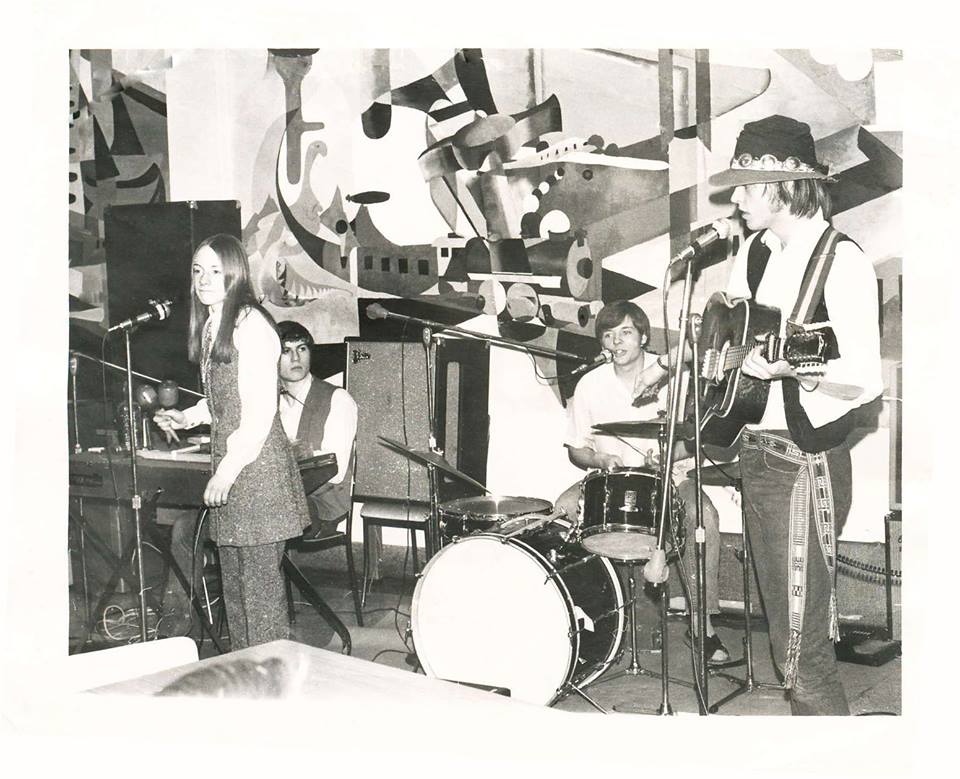
courtesy Beverly Ross
Their first gigs took place at The Barricade Coffee House located in the basement of Garneau United Church. Manager Holger Petersen started looking for more work, and a booking agent directed him to the Diamond Head room in Saskatoon’s Executive Hotel. Reese – now a film/theatre instructor at Red Deer College – recalls the band’s expedition – horror followed by relief:
Holger… got us a two week gig at the Executive Motor Inn in downtown Saskatoon. We arrived and set up to play only to discover (during our first set no less) that in fact we were supposed to be the back up band for some “exotic” dancers who just showed up on stage and starting stripping. I remember one dancer named Vicky who we dubbed “Victor” because of a certain bulge where on a female there should not have been one. Thankfully he/she never stripped down entirely…saved by a g-string.
Now Manna… was a folk/rock group with a lovely mild-mannered female lead singer, Bev Ross, and our repertoire consisted totally of our own compositions. In fact we prided ourselves on the fact that although most bands of that era played top 40 cover tunes to survive – we did not. However it became immediately apparent that this particular gig was not “our thing”. Perhaps the booing from the biker crowd and complaints from “Victor” were our first clues.
Petersen interjects “…we were told to play cover tunes or go home!” They also found that the stars of the Western Canada wrestling circuit were staying on their floor that week, so needless to say they did not get much sleep. Flamboyant wrestler Sweet Daddy Siki jumped on stage with Manna – without being invited – and sang a song with them. Petersen adds “it was bizarre, scary and over the top.” (in one of those musical crimes against nature, Siki would later release his own album called Sweet Daddy Siki Squares Off with Country Music on the Arc label)
Reese continues:
Holger, bless his heart, got us out of that contract within a couple of days. Since we were already in the area, and since we had some mutual acquaintances with Humphrey and the Dumptrucks, and since we had to heal from our beer-bottle dodging experience at the Executive Hotel we decided to stay in Saskatoon for a few days and celebrate Thanksgiving. I believe we stayed at Dumptruck singer Michael’s house.
Bev Ross:
Manna: all five of us and Holger, our manager, (and possibly a girlfriend or two), stayed in the Dumptrucks’ house for that gig in Saskatoon – was it called the Merry Mansion? – as Humphrey and the gang were on tour at the time and very kindly offered a free spot to stay – significant, as money was tight.
Laughs Petersen “…my “room” was a closet under the stairs!” Reese carries on:
Anyway we went to see somebody play at the coolest happening place in Saskatoon at the time…the Crypt. I remember going down some outside stairs and entering an oasis of hip music and wonderful artsy people. The crowd consisted mostly of university students and people with an appreciation for roots, blues, indie folk, FM radio (like CKUA in Edmonton) and music of sensitivity and quality – true, honest, left of centre original stuff. Can’t remember who we heard that night but I do remember a lot of vodka and a girl with beautifully long wild frizzy hair at a party afterwards (which went on ‘til dawn).
For us in Manna this club felt like a musical home, and boy did we feel lucky and honoured when Holger announced that he got us a gig at the Crypt… So we spent the rest of our two weeks playing the Crypt and the University of Saskatchewan and jamming with some truly incredible Saskatchewan musicians. In the early 1970’s on the prairies there were only a few places promoting this life style and music. Nowadays there is a thriving industry whose “roots” can be directly traced to musical ground breaking places like the Crypt.
Bev Ross seconds that:
I do know that it was an important gig for us, out of province for the first time. And that the Crypt, like the Hovel and the Barricade in Edmonton, was an important link in the long, thin, tenuous chain that was the original Canadian folk-rock-roots music scene in those pre-Juno, pre-Can-Con days. Manna opened for Iron Butterfly (!!) in Edmonton, but playing a club like the Crypt was us arriving at an audience that might really get what we were trying to do.
Larry Gelmon gave them a thumbs up. In his column he wrote:
There is a group playing at the Crypt this week that is well worth the listening. This is Manna, from Edmonton. The S-P [Star-Phoenix] labeled them as a folk-rock group, but that really does not do them justice. They do mostly their own material, and it ranges from all the way from medium-heavy rock to folk and mountain music. They use a lot of different instrumentation too, at times they sound like The Band, at other times like The Pentangle, and at other times like nobody else. The word “pleasant” has unfortunate connotations of syrupy ear listening music, but I cannot think of a better word to describe Manna’s sound. They have a very relaxing enjoyable sound, much the same sort of feeling one gets from the music of The Band, Joni Mitchell, or Dylan’s Nashville Skyline; a pleasant (that word again) change from the electronic mind-wrenching music that a lot of groups are still into. Go hear them. You’ll like it.
Things were starting to happen for Manna. In the fall of 1970 they signed a commitment to deliver a single to RCA Records. Upon their return to Edmonton, they went into the CKUA studio for several nights with Petersen engineering and producing. They recorded almost an album’s worth of their own material. Unfortunately RCA backed out of their agreement after the New Year. They opened for Iron Butterfly in December which really put them in the spotlight, and were highlighted in an article in the Edmonton Journal “The group is busy at the moment. They’re working on their first album; are negotiating a sound track for an NFB film, and will be making a college tour of western Canada with the Original Caste in January.”
The Original Caste tour did not pan out, but Manna signed on to another major tour of an Edmonton-based Jesus Christ Superstar show in March-April 1971. They were both the opening act, and then became a part of the vocal troupe for the main performance. The tour hit Calgary, Edmonton, Saskatoon, Regina, Winnipeg, Vancouver, and went as far afield as Detroit (Cobo Hall), Spokane, and even Hawaii.
The band lost several key members that fall, and they broke up shortly after. Bev Ross would record a full album in 1973 for the Century II label, but as the company went out of business, it was never released. She put out a solo album a decade later called Leap of Faith. Larry Reese also continued as a solo act for several years. He opened for Procol Harum at the Jubilee Auditorium in Edmonton when they recorded their November 1971 ground-breaking LP Live with the Edmonton Symphony Orchestra (and he played sitar on their track “In Held “Twas I”). Reese also scored several National Film Board productions for Edmonton-based director Gil Cardinal.
The folk vibe continued at The Crypt. Next up was another artist on her way across Canada who dropped into the Crypt for a week at the end of October. This was Montreal native singer/songwriter Dee Higgins who had recently signed a contract with Polydor Records and put out her first single “The Song Singer” b/w “Long Way Home.” She certainly appears to have had hype on her side – Melinda McCracken of the Globe & Mail wrote of her in February 1970:
Dee Higgins is sort of an ideal woman – she has long blonde hair, she’s young, pretty, has a beautiful voice, writes very simple effective love songs, and plays a pretty good guitar. She can’t help but be appealing. Her voice is clear and full, and her songs come across beautifully and easily.
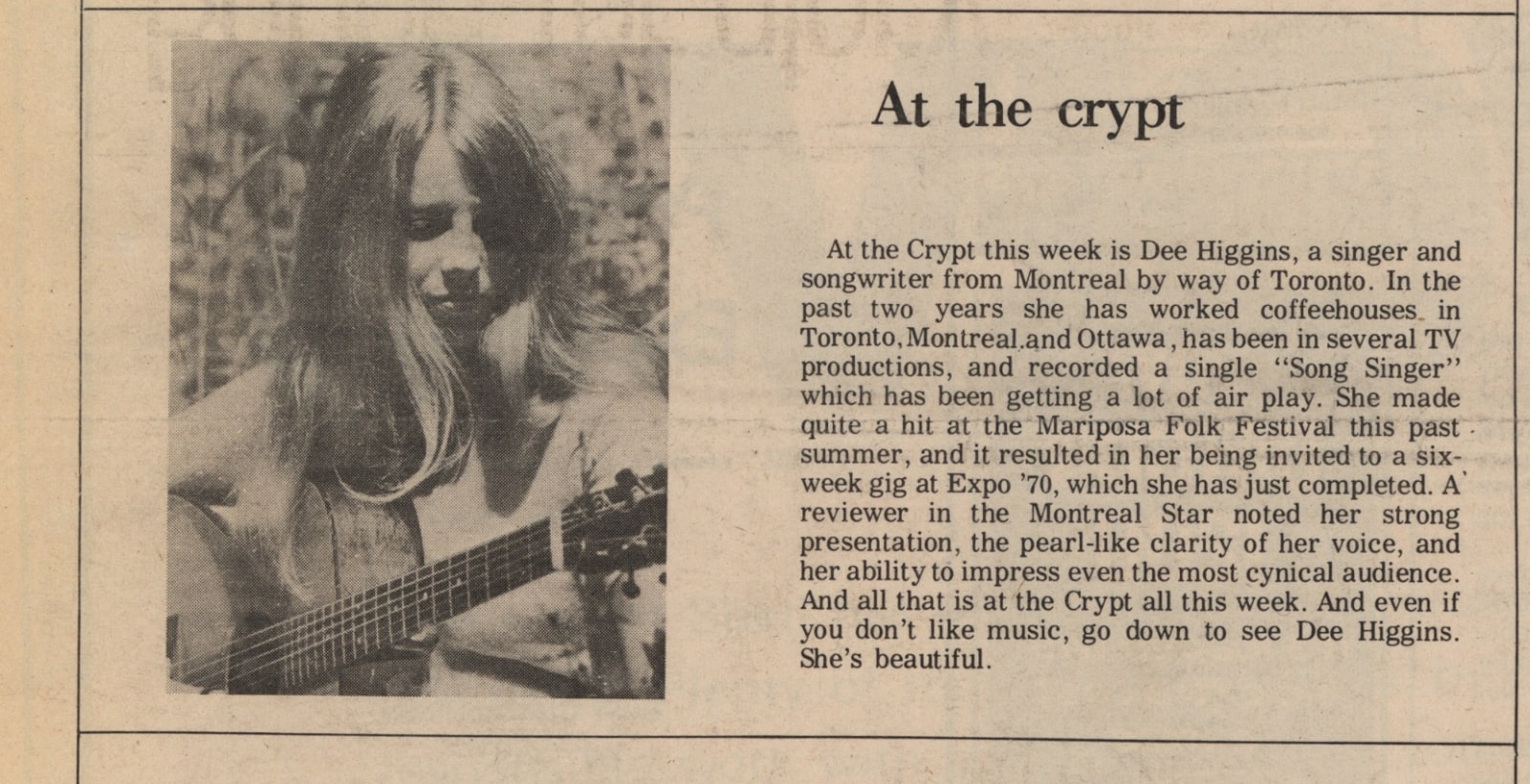
courtesy University of Saskatchewan Archives
She was mentioned numerous times in Billboard magazine that summer. First and foremost she had impressed industry players and audiences at the 10th Annual Mariposa Folk Festival in Toronto alongside Rambling Jack Elliott, Doug Kershaw, the Perth County Conspiracy, Rick Neufeld, and Bruce Cockburn. She was noted to be a member of the writing stable of Early Morning Productions along with Gordon Lightfoot, Rolf Kempf, Christopher Kearney and Ivan Burgess. An article in the August 15th issue announced:
Following her highly successful appearance at the Mariposa Folk Festival, Polydor’s Dee Higgins has been booked to fly to Japan for a six-week engagement at the Canadian Pavilion at Osaka ’70. Al Mair of Blythwood Music, which publishes most of her songs, says that Dee’s first single “The Song Singer” is starting to pick up action across Canada, and a college tour is being set up for the fall, when she returns from Japan. An album will be recorded at that time, and will feature mainly original material.
She was also on the public radar having played at the Global Village club in Toronto in April, the famed Nite Owl in Yorkville in June, and was videotaped singing the Leonard Cohen song “The Story of Isaac” in the CBC special The Good Company with host Alan Thicke two weeks prior to arriving in Saskatoon. She even came with a touch of street cred, for she had played at “The City is for People” demonstration in front of 8,000 people at Toronto City Hall in May 1970. The demonstration turned into a protest at the American consulate, and police responded by sending in horses to corral the crowd. Ninety one people were arrested.
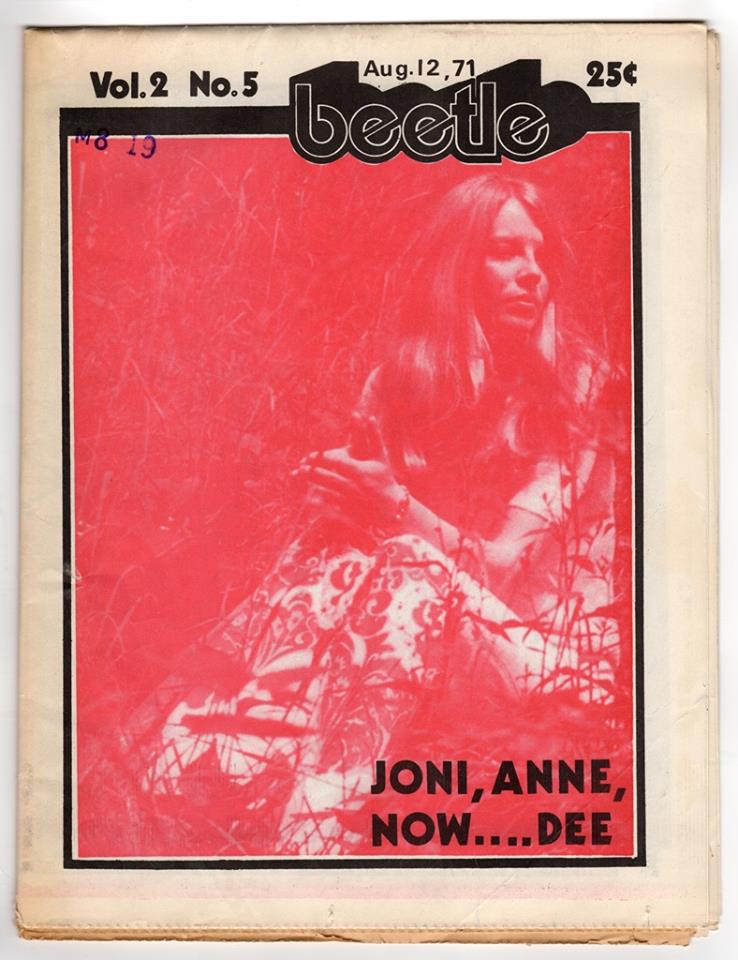
Pete White – the songwriting partner of Paul Hann – was involved with the planning and execution of Higgin’s recent tour. He recalls that she may not have eagerly jumped at the chance to play for the people of Western Canada:
When Paul first played the Crypt, I had already moved from Edmonton to Vancouver where in order to survive in the music business, I reinvented myself as an agent/manager… When Dee Higgins played, I think it was tied in with what I recall as “the fucking winter tour” that I put together with her, The Dumptrucks, Russ Thornberry, and Paul. She got included because Al Mair … wanted some western Canadian exposure for her and had phoned me looking for some gigs. The Crypt and Gastown Saloon gigs were the book-ends of the tour which hit the big cities of Castlegar, Lethbridge, Medicine Hat, and Regina (I think). We travelled by bus and it was totally low- end and Dee was bummed that Al had made her do it, believing she was fated to be the next Joni Mitchell. She saw it as slumming with Western Canadian low-lifes and would not socialize with any of us – though admittedly we were a little rough around the edges…
A fresh-face with indeed a Joni Mitchell-ish voice, Higgins appealed to both sexes for different reasons. An uncredited Sheaf writer (obviously male) profiled her:
At the Crypt this week is Dee Higgins, a singer and songwriter from Montreal by way of Toronto. In the past two years she has worked coffeehouses in Toronto, Montreal and Ottawa, has been in several TV productions, and recorded a single “Song Singer” which has been getting a lot of air play. She made quite a hit at the “Mariposa Folk Festival” this past summer, and it resulted in her being invited to a six-week gig at Expo ‘70, which she has just completed. A reviewer in the Montreal Star noted her strong presentation, the pearl-like clarity of her voice, and her ability to impress even the most cynical audience. And all that is at the Crypt all this week. And even if you don’t like music, go down to see Dee Higgins. She’s beautiful.
From Saskatoon, Higgins continued west and south, playing the original Troubador Club in Los Angeles and the newer Troubador in San Francisco. Then it was back to Canada where she dropped into Winnipeg to accept a Moffat Broadcasting Award for “The Song Singer” alongside its writer Rick Neufeld, and to play a three-night gig at the new folk club there called The Galley.
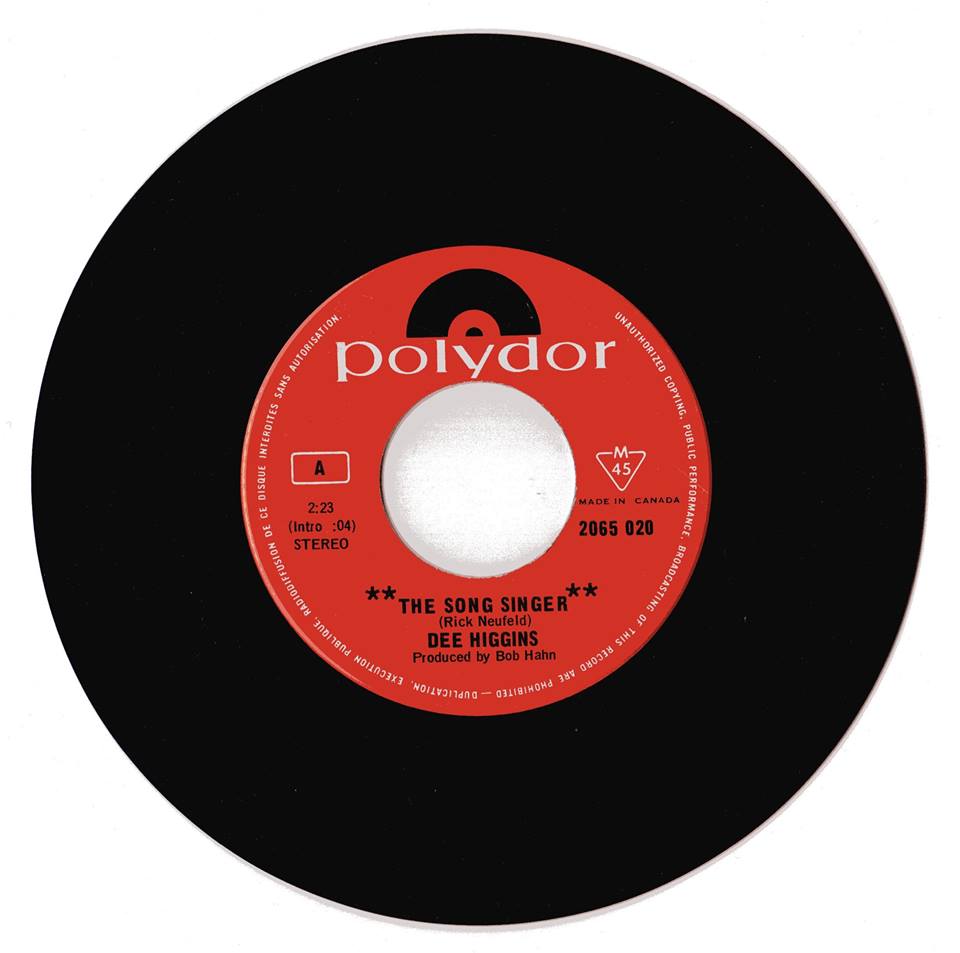
She signed with RCA Records in February 1971, and released a new single “Wishful Thinking b/w “Got to Find Someone to Love,” and later an album Love is Still Around in July – all to favorable reviews. Admiring her for writing nine of the eleven tracks, Andy Mellon of the Winnipeg Free Press wrote:
Dee, who hails from Montreal, has an album out now…which shows enough promise to indicate that she could be the next young Canadian to hit the folk music big time. Within the past several years, Canada has become universally recognized for producing some of the finest singers and composers anywhere. Names such as Gordon Lightfoot, Buffy St. Marie, Joni Mitchell, Leonard Cohen and Bruce Cockburn, to name a few are familiar to folk music lovers everywhere. Although Miss Higgins might not be quite ready to join them in folk’s higher echelons, she does have a way with a song that catches your attention easily… it adds up to a very pleasing record.
Higgins would become a fixture on Canadian television for the rest of the 1970s, making frequent appearances on Nashville North, the Ian Tyson Show, Rollin’ on the River, the Mike Neun Show, and Singalong Jubilee.
Paul Hann returned for his second engagement during the week of November 2nd. This time around he was a known quantity, had built up a fan base, and accordingly received a full review by Susan Jasper in the Star-Phoenix. She hooked in the readers quickly:
During the ‘50s and ‘60s coffee-house era when serious folk music became popularized, it had one outstanding characteristic; an audience reward that was directly proportional to the degree of attention. When Vancouver artist Paul Hann appears at the Crypt Coffee House tonight, you’ll recognize the principle is still alive, despite the intervening years of rock pyrotechnics. Invest the concentration that his words and music demand, and you’ll receive it back in triplicate because the man has obviously invested so much of himself in what he sings.
She continues;
Accompanying himself on six or 12-string guitar, Paul lacks the gimmicks that make soft-core entertainment a one-way easy street from the stage to the crowd – no inane patter, no diversionary jokes, no easy style that lulls audiences to peaceful inertia. Instead, he has a soft-spoken earnestness when he talks, and an amazingly powerful blues voice and style that can drop to a whisper if it’s necessary. And the 12-string musicianship is never allowed to overpower the most important facet, namely what he’s saying.
She then gives some of his background:
Born in England, Paul worked folk clubs there before coming to Canada three years ago where he’s been playing clubs, festivals, and television spots in Western Canada. He left England “because I worked in the English civil service – do I need to say more than that?” But he’s brought some English influence to his music in Ewen McColl’s Springhill Mine Disaster and truck-driving song. His strength is blues or country-blues as he calls it. His voice has the depth and power for Doc Watson, Fred Neil, and Richard Farina. Paul sings James Taylor’s Fire and Rain with Taylor’s wistfulness, but adds his own conviction to it.
She brings his writing partner – Pete White – into the story:
With Peter White, his manager, he has a unique working relationship, which is about to prove fruitful in a recording they believe. For Pete writes much of the material that Paul excels at, a thoughtful, thought- provoking, and articulate writer of personal episodes and feelings. In Queen of the May, Pete captured fear and spirit in a young girl from a small town who moves to the city and undergoes the changes young people know so well… although skid rows the world over have been written in verse, Pete manages to give Edmonton’s 97th Street a strangely sad dimension for a 24-year old.
She finished with a few comments about a possible folk scene:
Both Pete and Paul believe in the folk-music following… Coffee- houses and folk music are only just beginning in Western Canada, and prairie audiences in particular have an affinity for folk-music they said. If the Crypt Coffee House in Saskatoon stays alive, and others in Vancouver, Edmonton, and Calgary flourish, a circuit could be set up, says Pete… Neither Pete nor Paul are about to desert, despite the upcoming recording session. “A record adds exposure, but I just want to get around and play my music to people who like it” says Paul.
Hann would not realize that recording for a while. Pete White recalls:
In those days, getting an album was a huge deal. We’d had an offer from a studio in Vancouver but I thought we could do better, and so we moved to Toronto which turned out to be a totally stupid and retrograde move….after maybe the worse year of our careers, we moved back to Edmonton. We were flat broke but Holger Peterson offered us digs at his place behind Larry’s Barbershop and that’s where we lived for awhile.
This first album – entitled A Fine White Thread – was finally recorded and released in 1973. Hann became the first artist signed to Petersen’s label Stony Plain Records, and would go on to record three more: Another Tumblweed (1975), Paul Hann (1978 – with guest appearances from Mason Williams, David Essig, and members of The Dillards and Ozark Mountain Daredevils), and High Test (1979). There were two more for other labels Hometown Hero (1980) and Brand New Boogaloo Zoo (1982), and then a string of children’s albums. Hann became known as “The Cockney Cowboy” (after a 45 rpm of the same name), was nominated for two Juno Awards, and hosted his own television program entitled Paul Hann & Friends from 1982 to 1988 on CTV and YTV.
The following week – November 9-14 – Humphrey & the Dumptrucks took to the stage, and gave five full nights of benefit performances. All proceeds went to re-financing the Crypt. Singer was overjoyed, and spent most of the funds on redecorating the venue.
Although the Dumptrucks were everywhere and known by everyone in Saskatoon, they were difficult to pigeon-hole. Band member Michael Taylor described their music as “prairie music…It’s not country and western; that is, it’s not a conventional Nashville sound. It’s not rock ‘n’ roll. It’s not folk – though it incorporates all three.”
Having done their noble duty for God and Saskatoon, the Dumptrucks started their rise to jugband fame. They signed a recording contract with Boot Records in the first week of December, and almost a month later started recording their first album Six Days of Paper Ladies (an oblique reference to spending an unhealthy amount of time with magazine pinups) in Toronto’s Eastern Sound and RCA studios. For the two weeks it took, they stayed at the home of their friend and label-mate Stompin’ Tom Connors. The album was a minor success, and led to their appearance at the 1971 Mariposa Folk Festival and Saskatoon’s own Woodtick II Festival that summer. Although they did not include a song for the Crypt on that album, they did compose “Merry Mansion Quadrology” in honour of their infamous residence.
They seemed to have continually increased their following and garnered nothing but favourable reviews. A writer for What’s Up wrote of them in March 1972: “…always popular, always tasty in their light-hearted-headed-handed presentation, the evening seems to just stroll along as they run through their many Saskatoon favorites as well as new stuff from their…already recorded album “Hot Spit.”
This second LP followed before the end of 1971, and it also did well. They continued to play clubs and festivals (even the Prince Albert Penitentiary), and recorded one more album as a foursome: the aptly titled Saskatoon on United Artists Records. Graeme Card left the band in 1973 for a solo career, while the other three soldiered on with experiments in live recordings Gopher Suite (1974), musicals – Cruel Tears (1975 – co-written with Regina novelist Ken Mitchell), and ballet – Goose (performed with the Regina Modern Dance Co.). They appeared many times on CBC Radio especially This Country in the Morning, on CBC television programs such as Countrytime, and even founded their own label in 1975 – Sunflower Records. They finally threw in the towel in 1981.
Crypt audiences were surprisingly homogenous, considering the many different types of performers and musical genres. They fit almost perfectly into Singer’s predicted 16 to 30 years old age group – mostly University of Saskatchewan students with a smattering of adventurous high-schoolers and a few slightly older hipsters. During the week they were small in numbers, but most weekends the place would sell out. Larry Gelmon noticed this, and felt he should remind people that the club was open all week:
For those of you who have been getting down there, you may have noticed that the place has been packed on the weekend nights (with good reason considering the talent that has been playing) but the Crypt is also open Monday through Thursday, so if you’d like more room to get into it, trip down earlier in the week. Better yet, drop down more than once during the week. Musically it’s worth it.
Repeat customers were high in numbers – and high otherwise. The “atmospheric” smoke that both musicians and attendees fondly recall did not come only – or even primarily – from ordinary cigarettes. It was the tail end of the first heyday of recreational drugs in Saskatoon, and many habitues of the Broadway district – and particularly The Crypt – were serious and regular marijuana smokers. On any given night one could see a wide field of nodding heads, glassy eyes, and more headbands in the club. Stoners dominated the audience, but as The Crypt was a safe haven, they were exceptionally peaceful and overly sincere. An unspoken understanding evolved with the Broadway beat cop – he got his free cups of coffee, and in return he did not see any reason to venture past the front desk into the seating area proper.
Attendance was noticeably good in September and October of 1970. This was partially due to the buzz surrounding the talent being offered, and partly to the doors being left open all evening. The amplified music and coffee aromas wafting out onto Broadway Avenue attracted considerable walk-in traffic. With the colder weather descending in November, the doors were closed and the spontaneous sidewalk clientele lessened. The musical talent became more hit-and-miss, the novelty of the venue started to wear off, and the number of paying customers took a nosedive. Singer decided that a slightly new approach to talent and promotion was needed to bring back the regulars and reach out to the new. He decisively left the mainstream with his next booking, and the new daily paid advertising – in both the Star-Phoenix and The Sheaf – and from this point on it started to get strange.
An enigmatic, truly under-the-radar band called The Exit took the stage from November 25 to 28. They were originally from Rycroft in the heart of Alberta’s Peace River country. In their previous Edmonton-based incarnation called The Stonefield, they had recorded an obscure, distorted, self-penned, drug-addled 1967 single “Deep Shades of Blue” b/w “Morning Hours.” A recent review of the record by Aaron Levine on his website Weird Canada (weirdcanada.com) called it a “serious head-scratcher with its brutal fuzz massacre” and its “dual piano weirdness.” One side “oozes an addictive, lysergic weariness with its mid-tempo somber organ stuck firmly in a minor key while their drummer, seemingly in his own universe, augments the pacing with a complete disregard for drum pattern awareness.” The other side was “equally confusing, with a relentless bawdy piano swirling beneath the primitive fuzz lead…and bleary vocals…one of the most intense and ridiculous fuzz-guitar solos totally drowns out the entire track.” Levine, who traveled to Rycroft to unearth the story of the band, came back empty handed – they seem to have vanished from the face of the earth. He could only add that “they recorded in Edmonton and later reformed as The Exit, leaving the rest of the world to ponder the sheer awesomeness and absurdity of their legacy.”
Singer tried to make his advertisement in The Sheaf equally bizarre: “Expect anything at The Crypt. The Exit not only lives and breathes; tonight, Wednesday and Thursday, The Exit will even sing and play for you. All without the aid of chemical, optical, mechanical, psycho-physical or religious influences. See it and believe.”
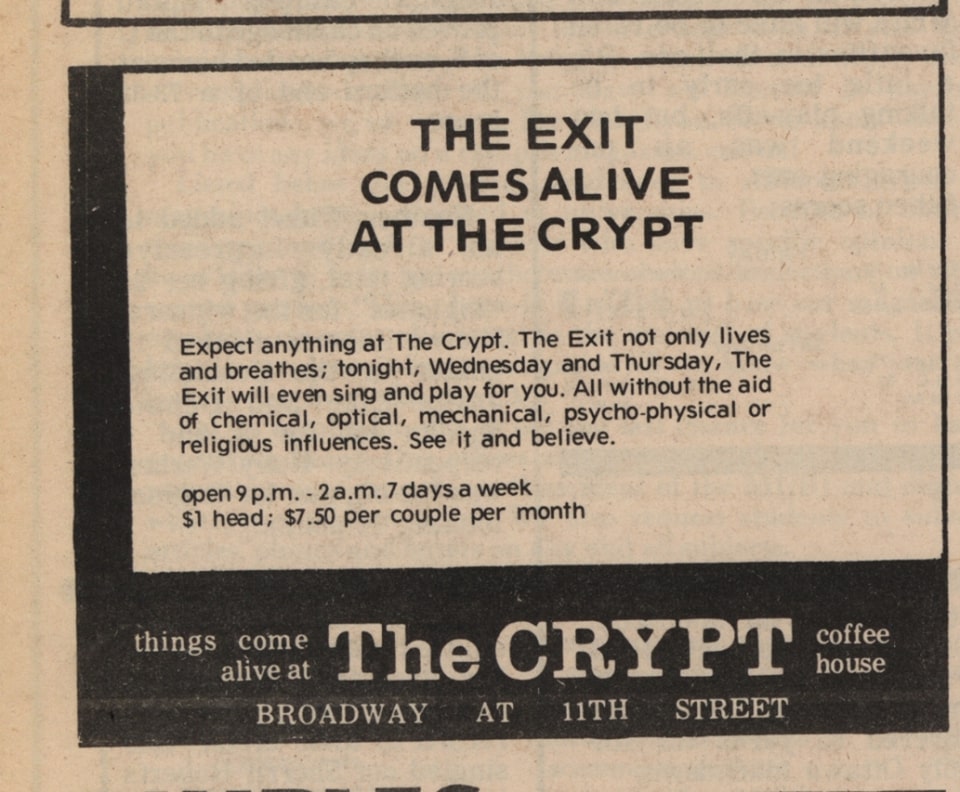
courtesy University of Saskatchewan Archives
No one knew what to make of them, or their three-night exploration into the dark side of musical atonality, and their searing and incomprehensible use of fuzz and feedback. The few Saskatonians who saw The Exit were either psychologically scarred or possibly lost all interest in music thereafter. Their performance was akin to going to a house party where something “uncomfortable” occurred, and all participants agreed never to talk about it again. While there are many audience members who gladly reminisce about seeing James and the Good Brothers or Paul Hann or Jalal – no one who saw The Exit has yet to come forth to recall the event.
On November 27th more print weirdness revealed itself in The Sheaf:
Home to the Sponge People. That is, to people who like to soak things up. Like live music. Teas. Coffee. Eats. ATMOSPHERE. People who dig breathing easy, but figure a night out should be fun too. So ease into the Crypt. It’s an absorbing experience.

courtesy University of Saskatchewan Archives
December 1st’s ad asked “Are You a Cryptomaniac?” and went on to say
It’s the catchiest thing since Christmas. The happy victims display the following symptoms…a compelling drive to keep returning again and again to the Crypt Coffee House (usually after a movie), an insatiable need of coffee, tea, eats, live music and ATMOSPHERE. The afflicted simply relax and enjoy it, at $1.00 a person or $7.50 a couple per month (for those in more advanced stages). Join them tonight.
It appears the new “edgy” approach did not reverse the decline. Singer realized there had been a slight derailment, and hastened to put the train back on the tracks with tried and true folk singers for the first week of December. Even the ads headed back in the direction of normalcy. The December 2nd one read: “WE’RE EYE, EAR, NOSE AND TUMMY SPECIALISTS” and then explained:
How so? Re-decorate a Coffee House so it looks as good as the name sounds, bring in first-class entertainment 7 nights a week (like folk singer Dave Wright from Edmonton, tonight and Thursday) and serve coffee, teas and eats that smell as good as they taste. It adds up to a complete evening. Drop down tonight for a treat-ment.
Wright recollections are short but sweet: “I do remember playing the Crypt for two or three nights in deepest darkest February?, I think. It was a really cool club, and the fella who put me up at his place was a real nice guy. Saskatoon fans and music aficionados are great. Very warm folks even if the weather isn’t …!”
And the December 4th advert played to the man about town:
For the après-show set. The end of a movie mean the end of your evening? Dull, dull, dull. Super bored, totally unimpressed chick. Absolute waste of swinging night hours. After the show is the time to begin a great evening by dropping down to the Crypt. Tonight and Saturday take in “The We’ed Two” from Lethbridge. Their bag is folk…
For two nights, We Two (not We’ed Two as the advertisements claimed – although that no doubt attracted a few more stoners) was featured. We Two was formed in 1969 while still in high school, and consisted of Kathy Pisko and Wendy McFarlane. In January of 1970 they entered and won the first Winston Churchill High School Folk Festival – an important stepping stone for Lethbridge. They were clearly superior to the eight other acts from their home town, Calgary and Edmonton. According to the Lethbridge Herald: “the two adjudicators complimented the guitar-playing duo on their confident manner, harmony and accompaniment in the four songs they gave.” We Too had had a busy year: they played at conferences, coffee houses, a free concert in Henderson Park at the beginning of July, and the Whoop-Up Days Exhibition coffee house at the end of July. Unknowingly they were preparing the ground for later two-girl/two-guitar groups such as Lava Hay in the 1990s, and Tegan & Sarah in the 2000s. The Crypt was the first out-of-province gig for We Two.
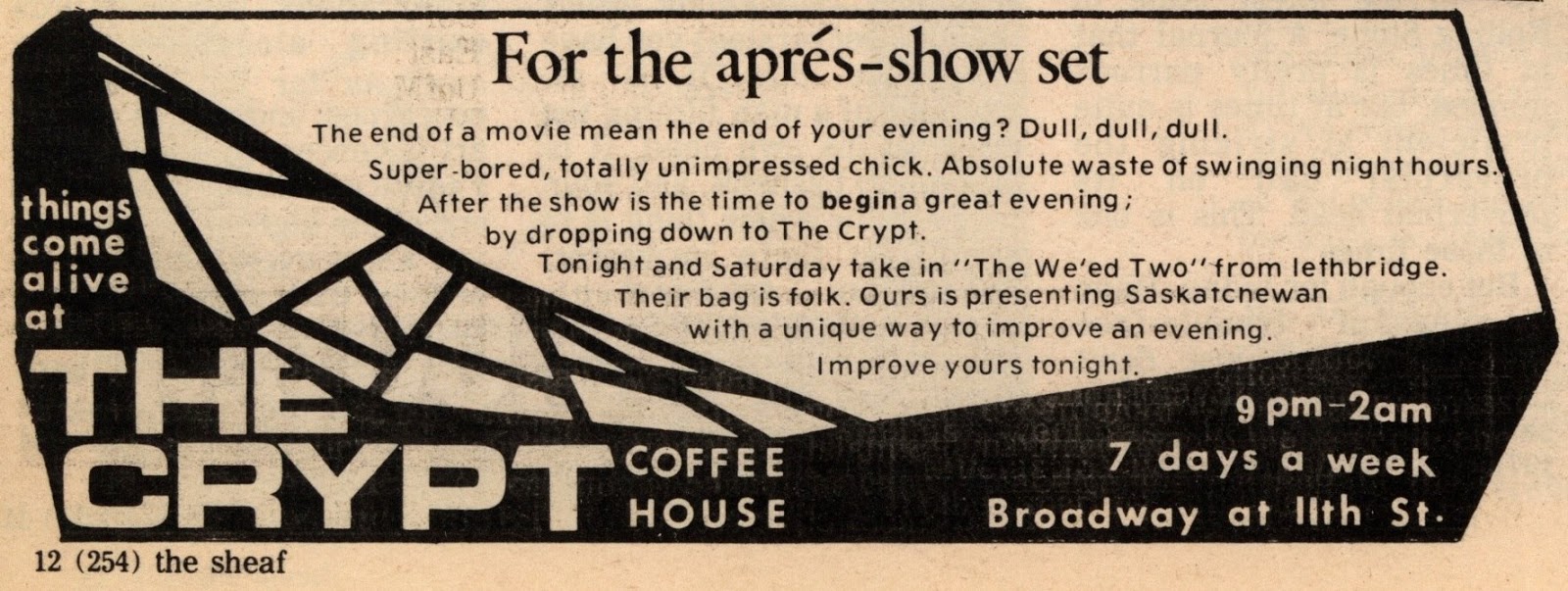
courtesy University of Saskatchewan Archives
This also did not succeed in bringing in the audiences, and with a lack of funds to pay artists, the Crypt remained without paid live entertainment for much of the second half of December. That is not to say the place was empty. It did however let a number of performers take the stage of their own accord. Recalls Singer:
We often had an empty stage during the week. I could only afford the out of town acts on the weekends usually, so lots of locals played those nights. We didn’t usually advertise them, they would put up flyers or call their friends and relatives on their own so there is little record of who was there. I only paid the union bands. Nobody seemed to mind the amateurs who sometimes played for free during the week.
Some of those free acts were memorable. Singer again:
One fellow sticks in my mind more than most. That is Romer Reo (his real name). He begged and begged to sing at the Crypt for months. We gave him a Wednesday night… We didn’t have time to put ads in any papers so I called my friends at the radio station and they made a big deal about it and about 12 people showed up. Romer got going about 9:00 o’clock and he was either pissed, high or just on another planet…[He] played his guitar until his fingers bled, sang until he went hoarse, and actually fell off his chair dramatizing one of his more autobiographical presentations. By about 10:30 he was still on stage but he was screaming, frothing at the mouth – and when he actually smashed his guitar …to make a musical point of some sort he was done. Guitarless he couldn’t go on. He had a friend who arrived about then and took him exhausted off the stage and out the door. We never saw him again. We had just enough letters to put “Tonite -The One and Only Romer Reo” on the sign that went round and round out side. I think it was his one and only performance, though there were rumors he played the university but was removed by security before the end of his first set…He was awful, but he was pleased to be given the… opportunity to perform.
He relates another story:
We had a couple of plays performed there as well by traveling groups. They passed the hat, I just provided the stage and refreshments. The only thing I remember about the plays were there was lots of nudity – but then who could forget that!… one group was from the States and another from Vancouver.
He goes into more detail:
[This] traveling bunch of actors… were in need of a venue on a Sunday night, when we were usually closed, to put on a play. We called all the radio stations for free advertising, cranked up the coffee machines, opened the door to a surprisingly sold out crowd, and they were wonderful. I can’t remember any of their names…maybe they are all famous actors now?
Sometime in mid-December (the exact dates can not be determined as there are no advertisements nor reviews) Saskatoon’s “jazz royalty” took to the stage for a two-night spur-of-the-moment gig. The Gordie Brandt Trio with Brandt (guitar), Barney Kutz (upright bass), and a drummer no one recalls, showed what master musicians could do with thoughtful, understated jazz. Both Brandt and Kutz had numerous decades of experience and musical knowledge. Both were raised in Saskatoon but ambitiously sought their musical education elsewhere. Brandt got his professional start in the country band Sleepy & Swede and the Tumbleweeds. He then found a spot more to his liking playing in various Vancouver jazz bands from 1941 to 1948.He then tried his hand at the Toronto club scene where he played with Vic Centro and Phil Nimmons, and joined the CBC radio orchestras led by Johnny Burt and Bert Niosi.
Brandt returned to Saskatoon in 1952, bringing a whole new awareness of jazz guitar to hometown audiences. He opened his musical instrument store and teaching academy in 1954, and not only prospered but “raised” the generation of guitarists which would come into its own by the middle of the 1960s. And by night he performed at local venues such as Club 400 (in the Avenue Building) and JayDees.
Barney Kutz, on the other hand, started in show business as a vaudeville tap dancer at the Empire Theatre in the early 1930s. He moved to Montreal in 1936 where he learned to play bass from Roger Charbonneau of the Montreal Symphony Orchestra. Kutz played in a jazz trio at nights, studied at the Quebec Conservatory of Music, and ultimately secured steady employment in the Jimmy Laing Band. He returned to Saskatoon for good in 1948 to take over his father’s tailoring business. During the 1950s Kutz was extremely busy – he played with the dance bands of Gordie King, Don Keeler, Ken Peaker and Ray Dahlen, became a permanent member of the Saskatoon Symphony Orchestra, and explored the rapidly changing world of post-bop “cool” jazz with his longtime friend on the CFQC television program The Gordie Brandt Show.
Brandt tried to make inroads with the younger crowd: in 1965 he played in the first jazz festival ever held in Saskatoon (it was organized by a young Skip Kutz) as well as at the second festival a year later. More recently his combo had played in the multi-generational “Seventypop Festival” in February 1970 at the Centennial Auditorium. The other acts included the University of Saskatchewan Jazz Band, the Tommy Banks Big Band, the Skip Kutz Sextet, Paul Horn, Witness Inc., Appleby’s, and Humphrey & the Dumptrucks.
Their repertoire at the Crypt was clean, crisp and classy…including ”Four on Six” by Wes Montgomery, ”All the Things You Are” (written by Jerome Kern and Oscar Hammerstein and made famous by Stan Kenton, Paul Desmond and Bill Evans), and “Bullfight” (from the 1965 George Benson Quartet album It’s Uptown).
It was an unexpected coup for The Crypt to get the Gordie Brandt Trio, and the city’s musical community came out in force. As well this was the only audience where a large proportion were past the age of 30. Unfortunately Brandt and Kutz were underappreciated by the segment of the audience who were not “in the know,” (or who were focused on the age of the performers rather than the obvious talent). Many of the younger attendees rudely left after their first set.
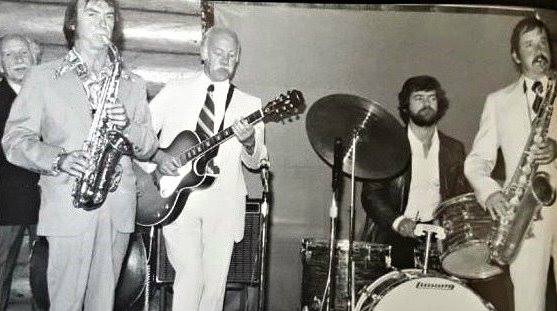
courtesy Kim Brandt
The swansong Crypt performances took place after the Christmas closure. On December 26 and 27, Jalal returned for three sparkling sets each night, playing to a full house. This third set of Crypt performances were staged during a brief hiatus on their Canada-wide tour. It had started in October in Yellowknife, carried on through B.C., and Alberta, and stopped for a week in Saskatchewan. (It would continue in Manitoba, Ontario, Quebec, and the Maritimes, ending in May 1971). The third Crypt stop made for magical nights in all respects.
Larry Brown reminisces about some special guests:
At the December concert, Mitch Ryder and the Detroit Wheels had performed in town the same night, and a bunch of them came down and jammed with us during the late hours. Our group before Jalal (the Mozart Group) had played on the same stage with them at the Montreal Pop Festival, so we had some previous connection with them.
Larry Gelmon again reviewed their concert for The Sheaf:
As you may know, Jalal, the group that was last in town early in the fall, breezed back into Saskatoon after a many-thousand-miled tour… they played about 75 concerts in 80 days, and they were more than a little exhausted when they got back. They played for two nights while here, and drew several hundred people each night into the sardine can that was the Crypt. Musically they haven’t changed that drastically since they were last here, except to get a little tighter, and make their jams a little longer… but the material they are playing, although we have heard it before, continues to be impressive. And their ability to draw crowds of dedicated listeners, such as no other Saskatoon group is able to do, speaks of their ability to communicate with music lovers.
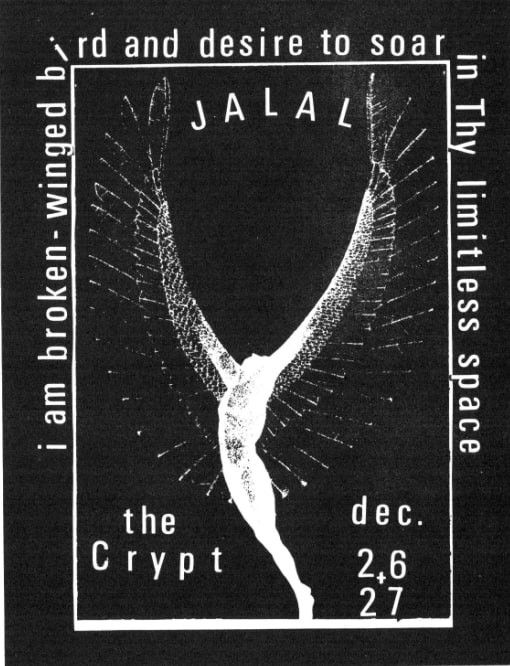
author’s collection
They continued on their cross-Canada tour for the next four months under the sponsorship of the National Spiritual Assembly of the Baha’is of Canada. They “performed concerts for informal gatherings, talking later with any who expressed interest in the faith.” Although they were quietly firm in their beliefs, they were not evangelical. Susan Jasper of the Star-Phoenix noted their balancing act in May 1971:
Jalal treads a thin line between conversion and conquest by virtue of its music. Jack Lenz says the order forbids overt conversion. “We just want to tell people we exist, all around the world” he says…According to Jack, the group would not at all be unhappy to make records and perform large concerts, but the earnings will be channelled back to the Baha’i organization. “We have very few thoughts about being commercial.”
They appeared on the CBC television program The New Majority in June to discuss the connections between music and religion. They also played an important double bill with Lighthouse at the University of Saskatchewan in July. A reviewer mused that “Lighthouse and Jalal together are something to go to: they’re both out on the edge of their own experience, learning and playing.”
By 1972 they were writing and performing lengthy and ambitious works – which even in the staging were no longer possible within a club like the Crypt. One was simply called “Four Seasons” – a multi performer extravaganza from the summer of 1972 that reminds one of a circus. The crowd was warmed up with Fred Kernan (emcee), the Theatre Project Players, Glen Erickson (dog act), the Epp Brothers (Mennonite folksingers), Gord Wilson (magic act), Glen Genthes (sword swallower), Sheila Bunn (poetry reading), Max Hanson (folksinger), and Susan Wright (surprise act). Finally Jalal appeared and played the four movements of “Four Seasons.”
The reviews were no longer universally positive: fans tend to dislike too much change. A writer for the local entertainment magazine What’s Up noted in June 1972:
…a local group they strike some wonderful rock n’ roll heights when digging into the past for those groovie goldies, but be fore-warned that their original material tends to encourage boredom as the energy is mired by lengthiness and what often appears to be over-self-indulgence.
Their crowning glory was a joint concert with the Saskatoon Symphony Orchestra at the Centennial Auditorium called “Jalal and 73” It was so called because it took place February 9, 1973 and there were 73 orchestral accompanying instruments. The SSO performed Ernest Bloch’s “Sinfonia Breve” and Brahms’ “Serenade in D”. They were then joined by Jalal to do two exploratory, complex and …well, symphonic…original numbers entitled “Prologue: The Great Announcement” and “Love is the Mystery of Divine Revelation.” By this point Jalal – much to the chagrin of many of their long term followers – had completely left behind their cover tunes, and had firmly established their new identity.
Later in 1973 Jack Lenz moved to Toronto to expand his musical horizons. While there he hooked up with Seals and Crofts, following them to Los Angeles where he became their arranger, composer and band member. He played on their 1975 LP I’ll Play For You. He also was in Loggins & Messina’s band for their last album entitled Finale (1977). Lenz was enticed back to Canada by composing and production work in television (90 Minutes Live with Peter Gzowski, Due South, Robocop: the Series, Doc, Sue Thomas: FBI, Atomic Betty, and Little Mosque on the Prairie), movies (Mel Gibson’s Passion of the Christ, Men with Brooms), theatre (Tribute to Mordecai Richler), and especially advertising. He also wrote the opening themes to numerous programs on CBC, CTV, and Global – not to mention the Blue Jays theme “OK Blue Jays” with Tony Kosinec (which, when issued on True North Records, sold so many copies that it became a “gold” single). The Brown brothers assembled bands under the name The Mozart Group from time to time throughout the 1970s and 1980.
With the start of the new year 1971, Singer frankly assessed his financial position, and realized he did not like the look of it at all. In retrospect, the Crypt should have been prospering. All the criteria were present for a truly enjoyable 1970 night out for both women and men. The patrons had nothing but favourable experiences, and most returned weekend after weekend. There was no rowdyism or drunkenness in the club itself (that was saved for the post-concert parties). The various musical acts wanted to play there – and the club received great ratings when members of the Canadian music community compared notes. The performers were paid the lowest scale fees permissible with the American Federation of Musicians (Singer stressed “we always paid scale, but couldn’t afford a penny more”), and the Crypt rarely had to pay for accommodation. The Saskatoon acts did not need a hotel, and those artists passing through usually passed out on the floor of the Dumptruck’s house across the alley. Cheap advertising was mostly done in The Sheaf or on the radio by talking to the disc jockeys and having them talk about the upcoming acts.
Yet it was not ultimately successful for several reasons. Firstly it was a totally independent venue. It was not hooked into a circuit like the Louis Riel Coffee House enjoyed. Singer did not want to deal with any booking agency exclusively (especially Saskatoon’s pre-eminent agency Actron with whom he had had serious arguments), so there was not the steady, reliable stream of talent. Almost every week’s booking involved phone calls, negotiations, accidental meetings, subtle poaching from other nightclubs, and especially off the cuff personal recommendations. And although Singer recalls being desperate for performers only once or twice, it still took up an inordinate amount of time.
Some days of the week brought in more money than others; some weeks were better than others, and some months were better than others. Over the five months though – on average The Crypt never managed to make a profit. The chief factor as usual was finances. Though it seemed reasonable at the time, the cover charge was obviously too low. The purchase of the food and coffee supplies – usually for a week at a time – was a major and continuous outlay for Singer. Payments due to the performers, and wages to the staff had to be paid regardless of how much money came in from the cover charges and food sales. In essence then, the Crypt was subsidized throughout its short life from the profits made by the Sol Store. Recalls Singer: “I made as much as the average Canadian poet, though we got to eat a lot of cold cuts and buns that were left over.”
Larry Gelmon comments: “The lack of a liquor license is what probably killed it — hard to pay a class act on coffee receipts…And it would have been more successful if Barry (and Lee) had been more of a gatekeeper and not let in so many of their friends (me included) for free.”
In the end Singer had to walk away from the Crypt to keep the Sol Store solvent. The lease once again reverted to Lyle Wallace. He recalls that Wallace: “actually tried to run it on his own, though I can’t remember if he actually had a group play or not. He eventually sold it to a fellow called Adrian Stockings. The place stayed open for about three months after I left.” It was not a glorious finish: the bombastically-named Sox & Stockings Rock Palace did not advertise, nor is it mentioned in Ned Powers “Sights n’ Sounds” column. No one knows when it opened, no one knows when it closed for good. There is only one documented band that played there – the Andantes from Regina.
The Crypt is fondly remembered by both performers and audiences. It certainly left a legacy – a legacy of openness amongst Saskatoon popular music aficionados for all types of live music, and an established and hungry audience awaiting the next club or clubs that could provide it. For performers it played an acknowledged and pivotal role at the beginning of their careers, and left a legacy of feeling welcomed and appreciated. As well it established a basis for future musical networking and collaboration. Holger Petersen recalled on behalf of Manna “… we felt really good about the Crypt. It was a listening audience…they were supportive and appreciative…we felt encouraged to keep doing original material.” Existing and prospective club managers took note of the Crypt’s popularity, and quickly moderated their stand on cover band-only bookings. By the following summer many of the acts that played the Crypt were being booked into the more mainstream clubs – and their original material was welcomed.
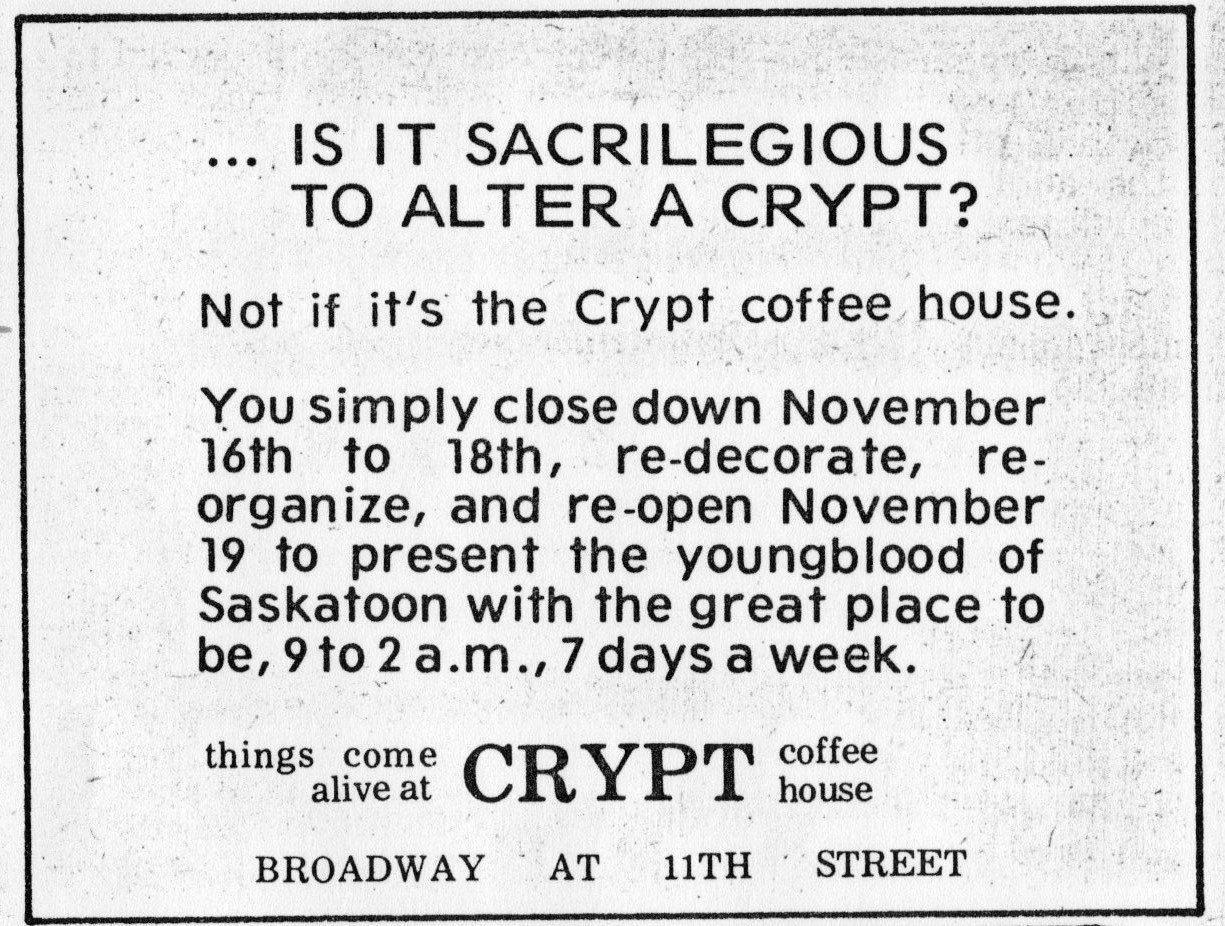
courtesy University of Saskatchewan Archives
The spider webs of musical cooperation started to be spun immediately, and some were holding strong almost four decades later. For example Humphrey and the Dumptrucks recorded a song called “Pretty Mairi” about Mairi Maclean of Skip Kutz’s band, and she in turn sang on their album Cruel Tears. All of the Dumptrucks appeared on Paul Hann’s first album A Fine White Thread in 1974, and the original foursome reunited to play at Hann’s wedding in 1978. Bob Evans of National Washboard & Co. made the leap from being a Dumptruck admirer to being a Dumptruck in 1977. He had played on the CBC broadcast “Air Mail Special” as a solo artist, and then joined the Dumptrucks for several songs. They then recruited him to replace Humphrey for the recording and touring of their next LP Goose!
Hann co-wrote a song with Bev Ross of Manna, and recorded another song penned by Alan Rhody on his Hometown Hero LP. The Good Brothers recorded three other Rhody songs over the years – “Mighty River”, “The Garden Wall” and “I Really Dug Myself a Hole This Time.” Rhody describes their post-Crypt relationship:
As for the Good Bros…..we’ve been bosom buddies all these years. We’d meet up in … the infamous Richmond Inn, which was a decent little bar gig for a solo upstairs, and … later bands downstairs in their large room which is where the Goods played quite a bit back then. They’d come upstairs sometimes on their break and sit in, or I’d go down stairs on mine and sit in with them…. it was always fun. Then after I’d moved to Nashville and they went on to become very popular up there, we stayed in touch and they asked me to come up and do a northern Ontario tour with them in ‘80 and a cross-Canada tour in ‘81 – both very memorable experiences! We still co-write (Bruce and Brian, Larry doesn’t write) whenever possible up there or down here, whichever works and they’ve included a co-written song on each of their last three releases. And we still get together whenever possible just for a visit, etc…Great guys and long-time musical friends.
Rhody also recalls spending time with Hann:
Paul Hann, Pete White and I became fast friends in Vancouver not long after my Crypt gig, when we were all in Vancouver. I’d been on the TV show in Edmonton a time or two by then. I really liked Paul and Pete a lot and they’d come by my place and mostly just played songs for each other and drink beer or go to one of the local pubs. We’d talk about our hopes for the future, songwriting, kind of a mutual admiration society of three (ha!).
Hann and Humphrey and the Dumptrucks became regulars at the Winnipeg Folk Festival in the 1970s, while Hann and Bev Ross played the Edmonton Folk Festival throughout the 1970s and 1980s. Jalal, Jr & Dudley Dean, Humphrey & the Dumptrucks, and Gordie Brandt all appeared at the Woodtick II Festival in Saskatoon in August 1971.
The Dumptrucks, Manna, Rhody, Hann, Wright, and Mairi Maclean (with her next band called Fat Chance), all appeared on Holger Petersen’s long-running CKUA radio program entitled Acme Sausage Company. Petersen assembled and produced a various artists album in 1972 by the same name, and on it were Humphrey and the Dumptrucks’ “Third Song,” Paul Hann’s “Workin’ Up the Line,” Manna’s intended RCA single “Uncle Clarence’s Piano,” and Larry Reese’s “Second Song.” Mairi Maclean and Bev Ross (along with Allen Stein and Tom Crighton) co-wrote a CBC radio (Edmonton) drama pilot entitled “Thurston Bradshaw: Not Gone, But Forgotten” – the story of a fictional band leader. According to Ross:
We invented a prairie band leader from the swing era, faked his life and times, including his songs (my favourite was “I’m Gonna Write You a John Deere Letter”) and had great fun putting it together. It aired as a one-off but didn’t fly as a series – thanks to “This is That”, I can cling to the notion we were ahead of our time.
Both Hann and Larry Reese played and sang on a children’s album on Mudpie Records entitled Ice Cream Sneakers in 1980. Gord Pendelton and Gordie Brandt contributed two songs each to the 1982 commemorative album Century Saskatoon 1882-1982. Graeme Card of The Dumptrucks and Hann both contributed songs to the ambitious and heavily-hyped, but commercially unsuccessful concept album Cantata Canada from 1973 on Century II Records. Finally several of the Crypt performers were sought out by and released material on the independent Canadian record label Boot Records. It was founded in 1971 by Jury Krytiuk and Stompin’ Tom Connors to promote the careers of Canadian (and some international) country, bluegrass and folk artists. Both Alan Rhody and Gord Pendleton had their first single releases on Boot Records, while Humphrey and the Dumptrucks issued five singles and two LPs on the label.
Pete White sums up this period:
For Paul and I and our days together in the music business, Edmonton was home, Vancouver was heaven, Toronto was hell, and Saskatoon was the best stop on the road ever. It had a special spirit which had to do with our good friends the Dumptrucks who we always got drunk and stoned with; and of course because of those early days at the Crypt.
The final word rightfully comes from Barry Singer:
I have no regrets at all…The best part of the Crypt was the music, and learning about that business. The musicians were really screwed by their agents, the club owners, record companies and publishers in those days and I felt sorry for them. Indeed, when I was a lawyer, I used to act for the Musician’s Union. However, they made that all up in life style, and I still wouldn’t let my daughters date one, as if I had a choice!
In summary, The Crypt was both a success and a failure. As a series of closely-sequenced musical and cultural events, it was a roaring and memorable success. It offered a smorgasbord of new (and some older) music to Saskatonians who were open to it, as well as a first important step up the entertainment ladder to many unknown acts. But as a self-sustaining commercial venture without a liquor license, it was totally unrealistic.
Brock Silversides
Director – Media Commons
University of Toronto
Crypt Schedule
Pre-opening week
Humphrey & the Dumptrucks
17 – 22 August
Skip Kutz Sextet (with Mairi Maclean)
(grand opening)
24 – 28 August
Rick Dawson, Keith Bartlett
2 – 5 September
Paul Hann
7 – 12 September
Jalal
15 – 19 September
James & the Good Brothers
21 – 26 September
Jalal
28 September
Al Bond, Steve Carter
29 September
John Briscoe
30 September
Ron Dixon
1 – 2 October
National Washboard & Co.
4 – 6 October
Gord Pendelton
7 -10 October
Alan Rhody
12 – 17 October
Jr. & Dudley Dean
20 – 24 October
Manna
26 – 31 October
Dee Higgins
2 – 7 November
Paul Hann
9 – 14 November
Humphrey & the Dumptrucks (benefit week)
16 – 17 November
closed for renovations
21 – 26 November
The Exit
2 – 3 December
Dave Wright
4 – 5 December
We Two
mid-December
The Gordie Brandt Trio
26 – 27 December
Jalal
January 1971
New management – becomes Sox & Stockings Rock Palace
© Copyright Brock Silversides & psychedelicbabymag.com

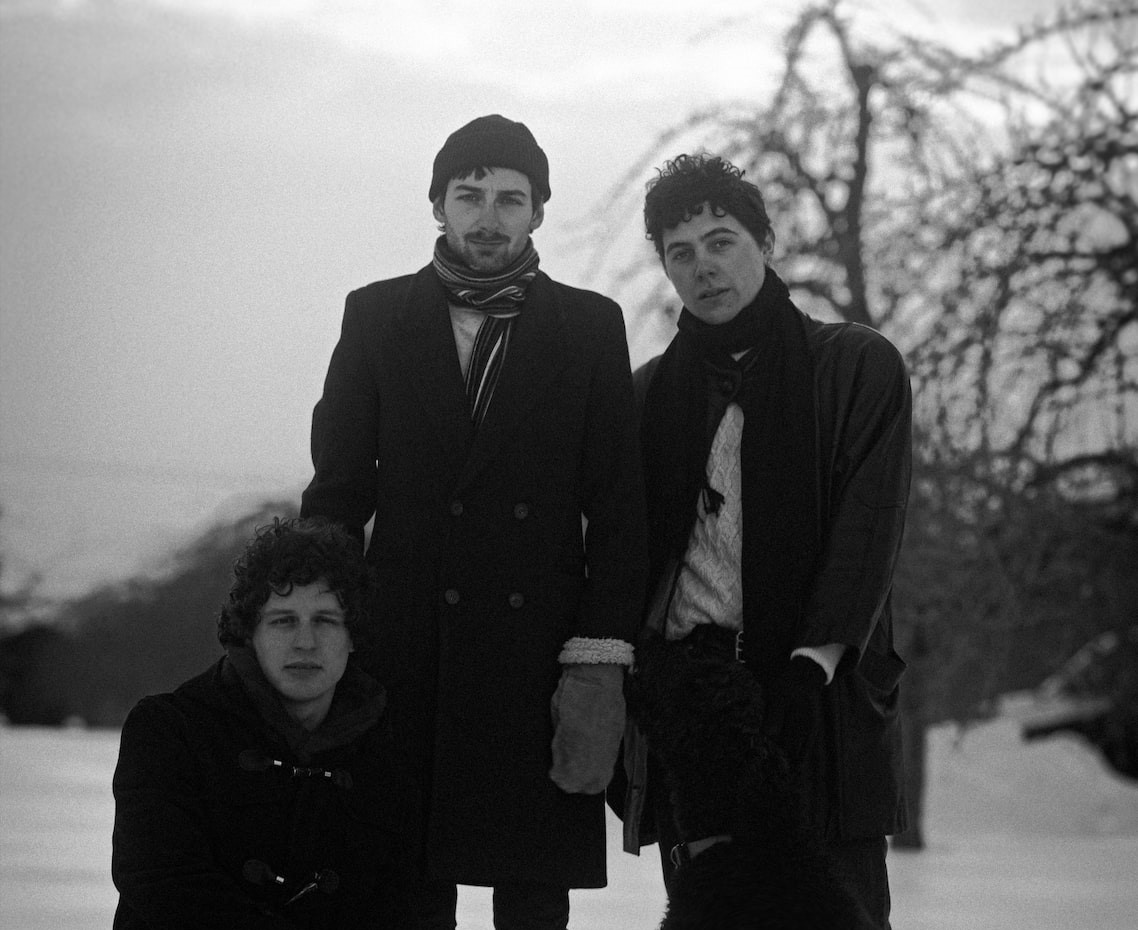
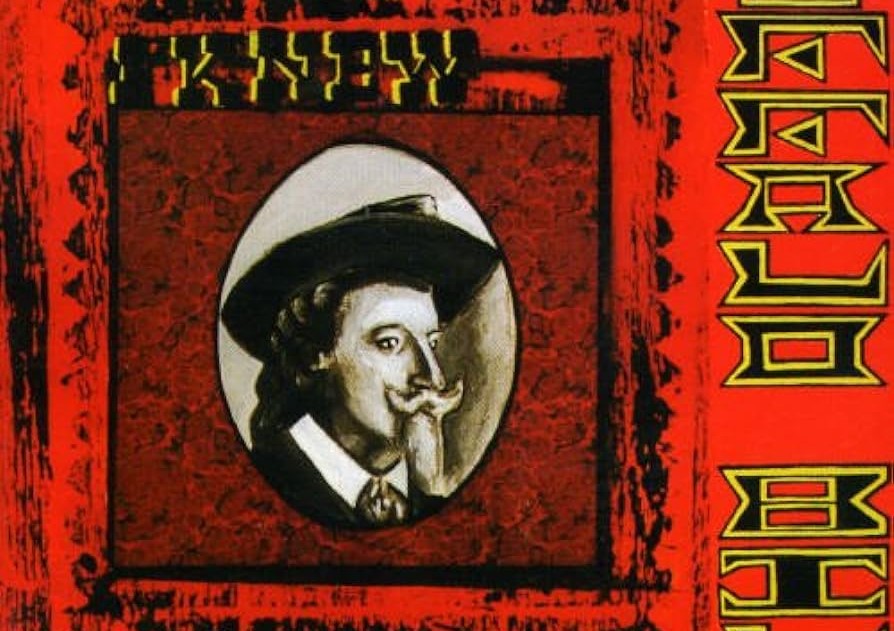
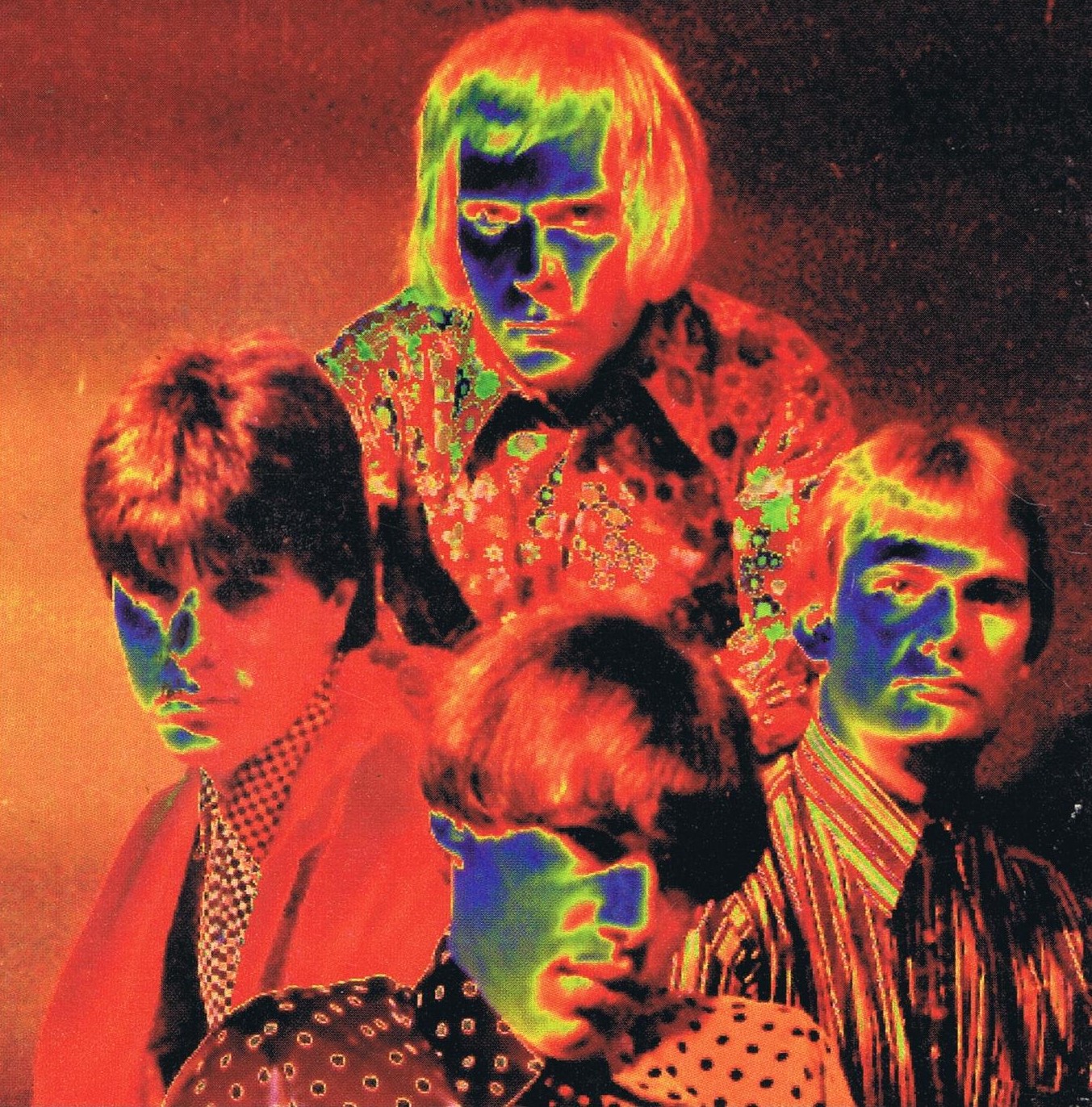
Brock, thanks to your excellent pen, my memories just became socially relevant again! 🙂 – Keith
Fantastic! And to think we thought it was just "Bob's".
I grew up in Saskatoon, born towards the tail end of the era covered in the article (1973). I went to Victoria School, and even occasionally was in the Farnham block which later housed a popular pub named Lydia's. I recognize several names of individuals and bands in the article. If I recall correctly, the church pews were still part of the furniture in Lydia's. Thanks for a great trip down memory lane!
It was wondering if I could use this write-up on my other website, I will link it back to your website though. Great Thanks.
NW Calgary Dentist
Dentist in NW Calgary
Nice Informative Blog having nice sharing..
Dentist in Waterloo,ON
waterlo dentistry
That such thorough 'scholarship' can be done on such an ephemeral entity – wow! Being 18 in 1970, and a hanger-out in the Farnam Block, it was a fascinating memory revival show. Wildly red-headed Kelly Marble, the unforgettably strange Romer Reo, the Merry Mansion – my, what a cast of characters. Thanks for the research…
This is fantastic, Brock! Many thanks.
Fond memories.
romer reo is just his stage name and library was next door to lous riel coffee house next to broadway theatre
Your article is a blast from the past for me. I started Uni in 1969 and remember these bands and musicians well. The tremendous research Terry Holness has been doing means Saskatoon musicians throughout the past 50 years will live on in print well into the next century. Thank you, Terry!
I misspelled Terry Holness’s surname. Please edit my submission. Thanks.
HOKNESS